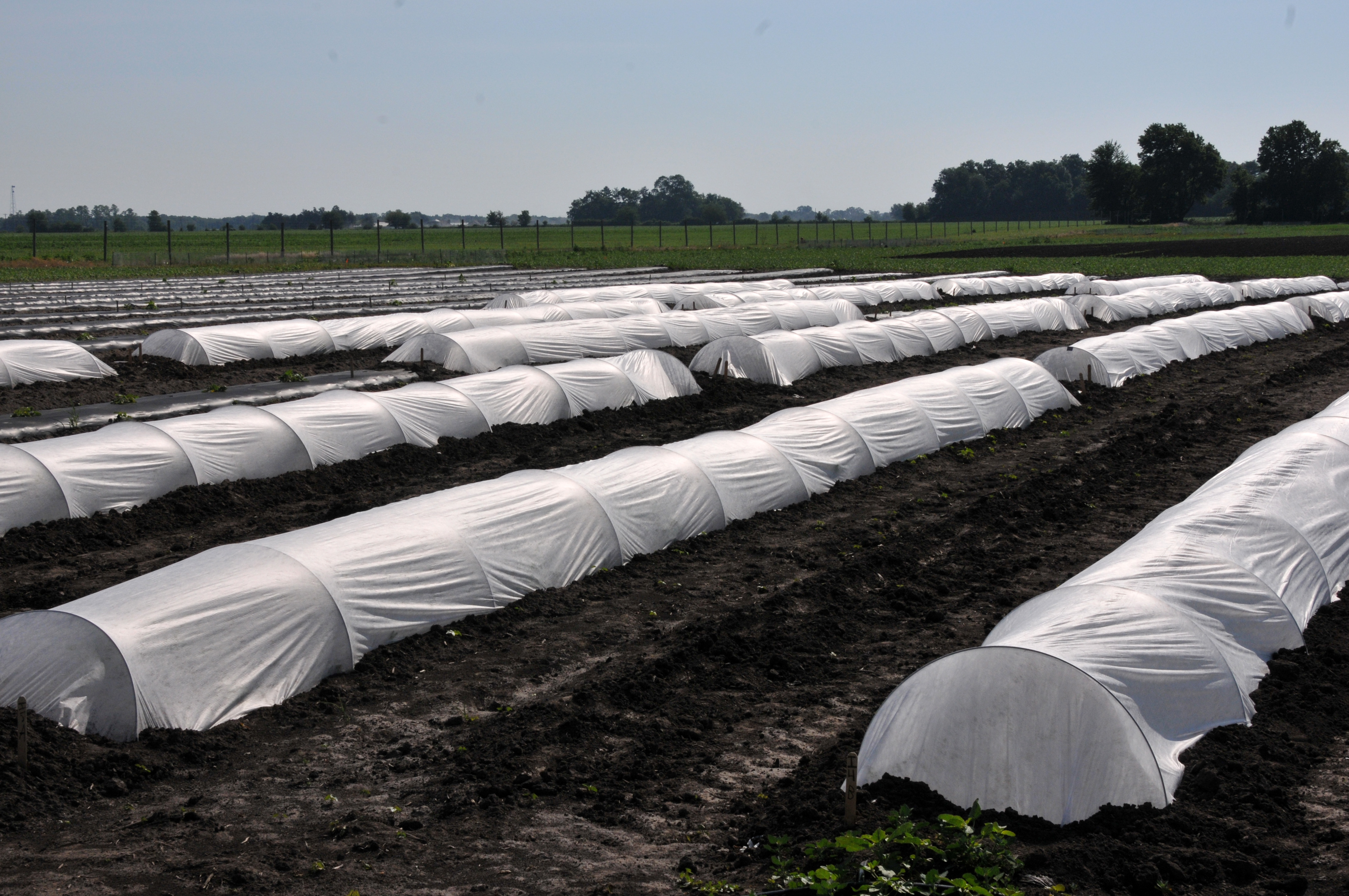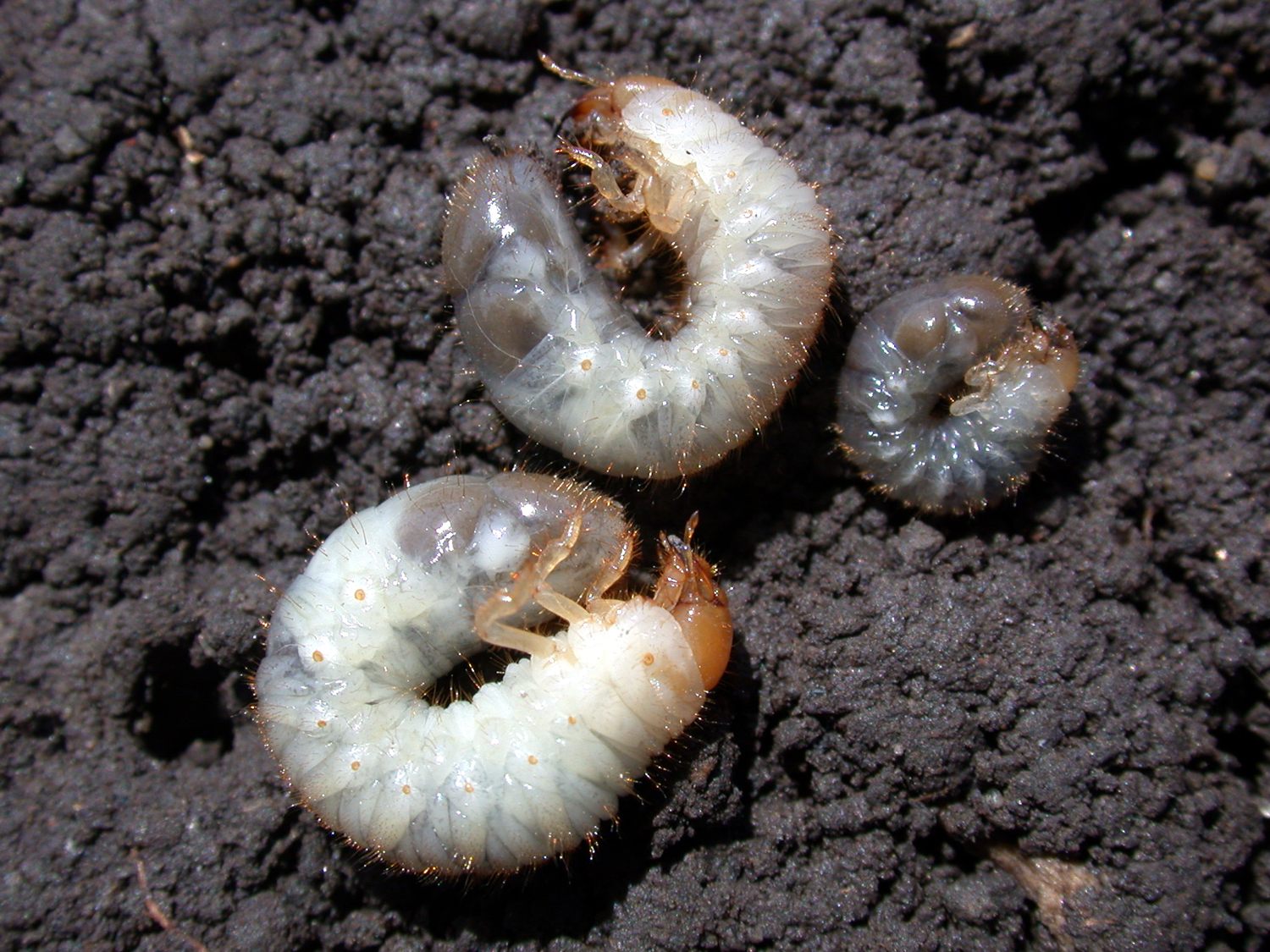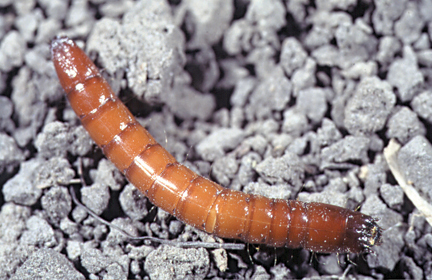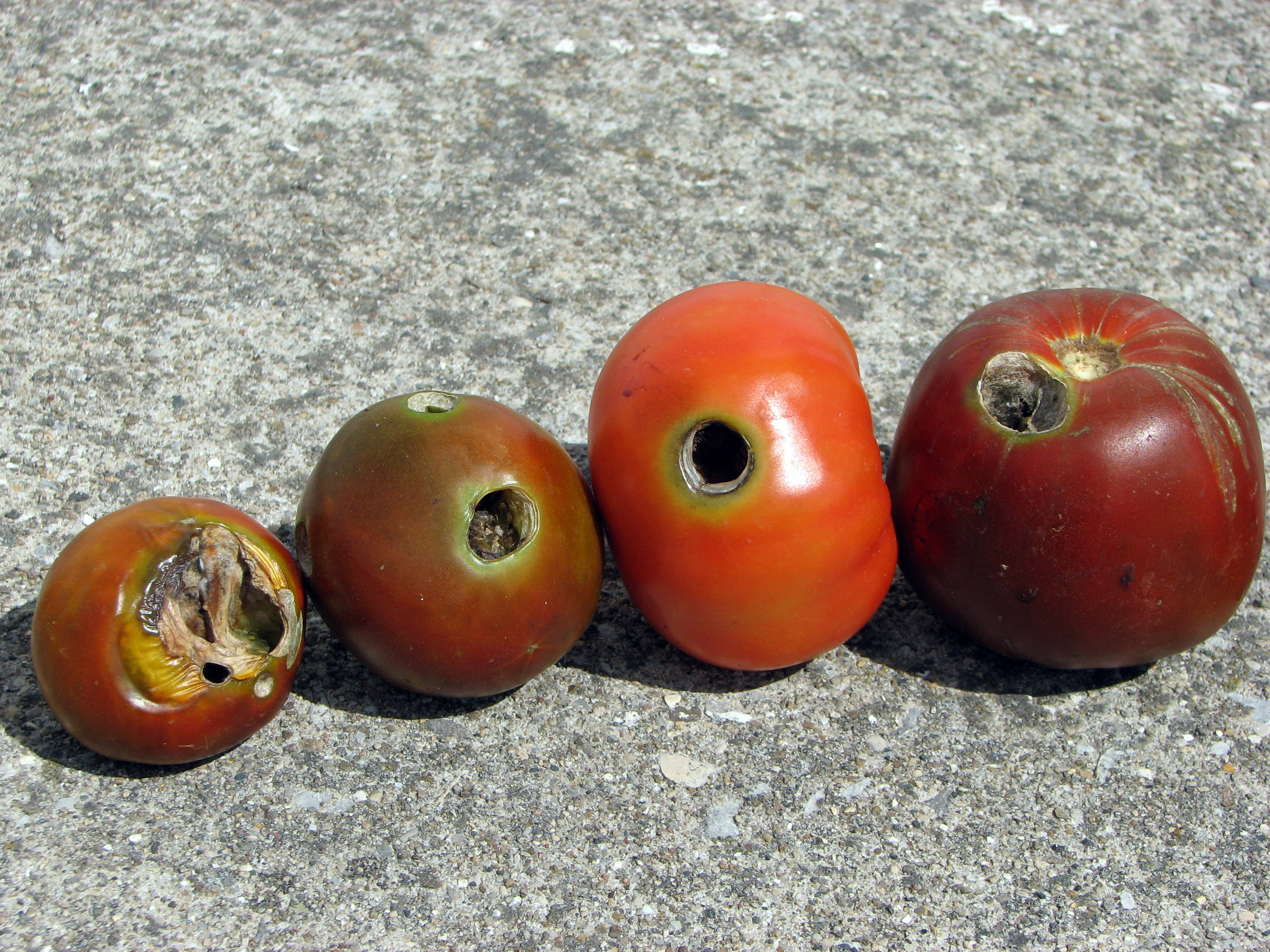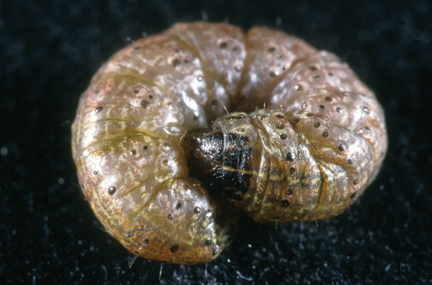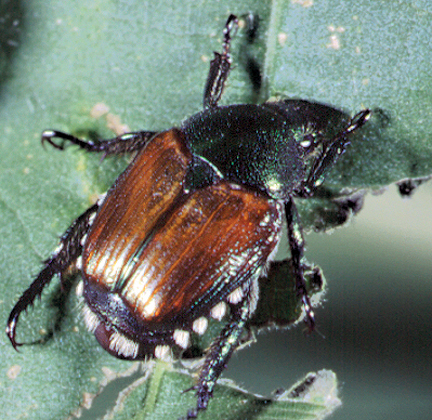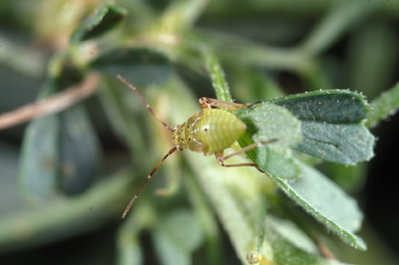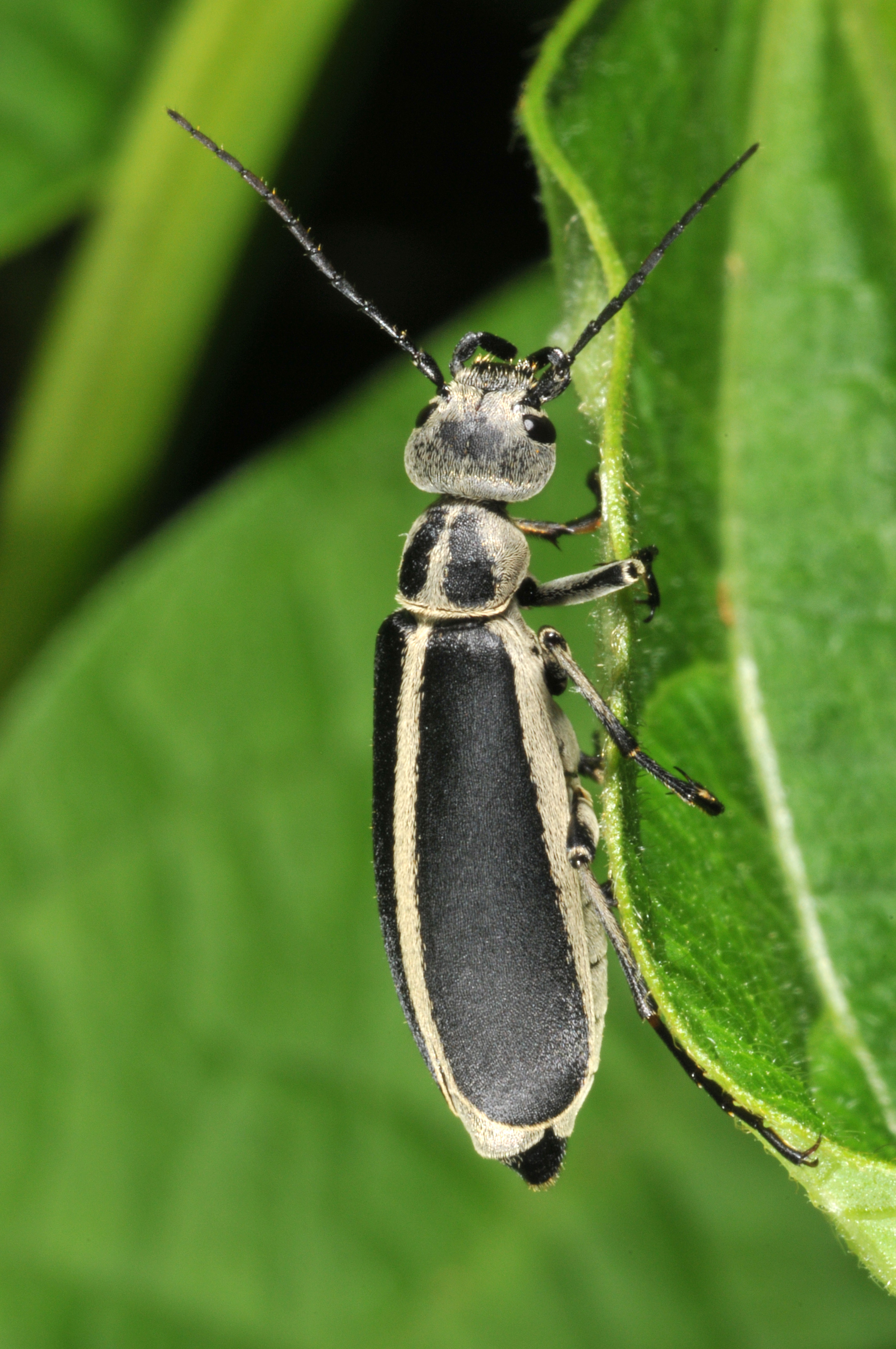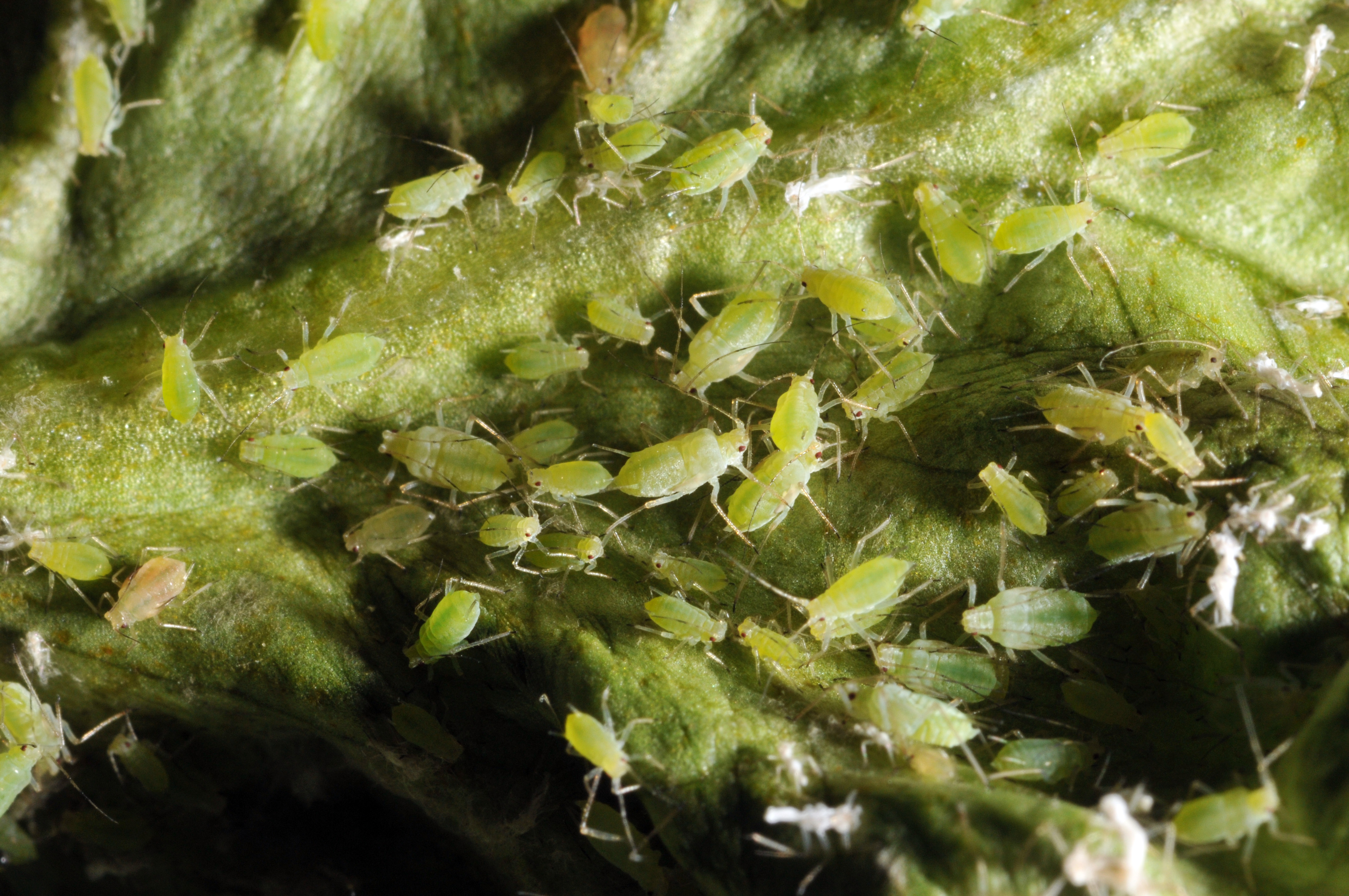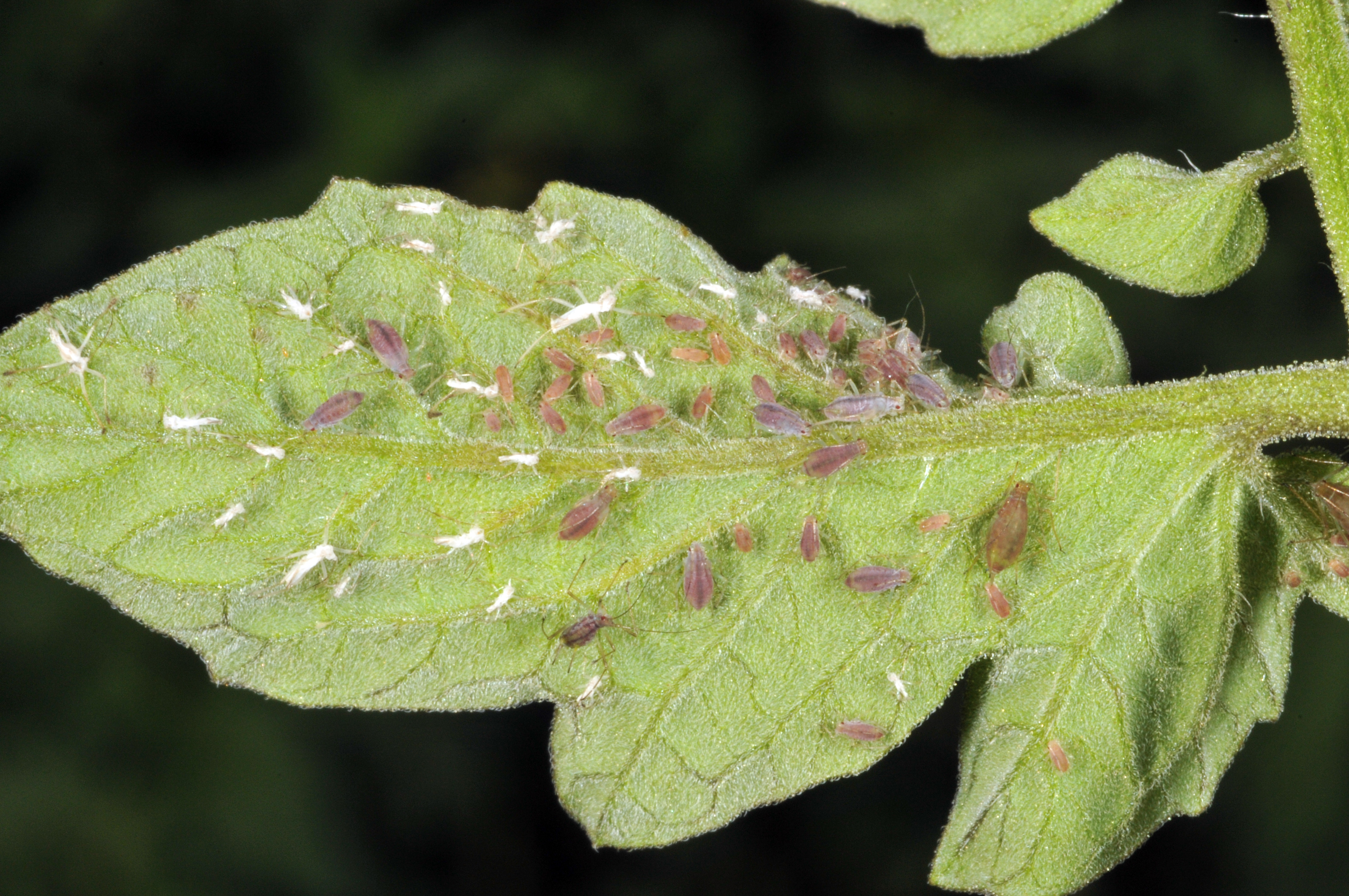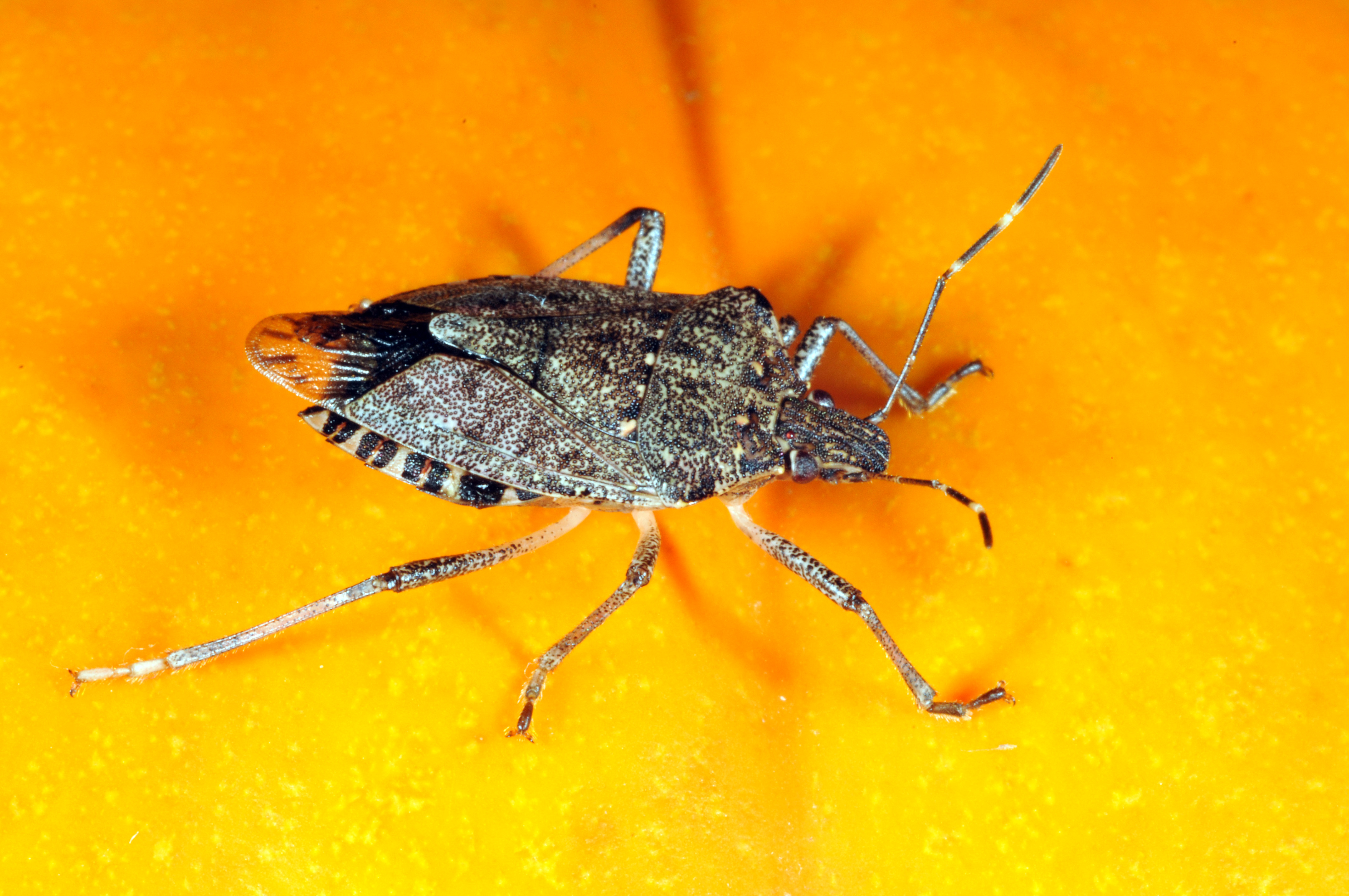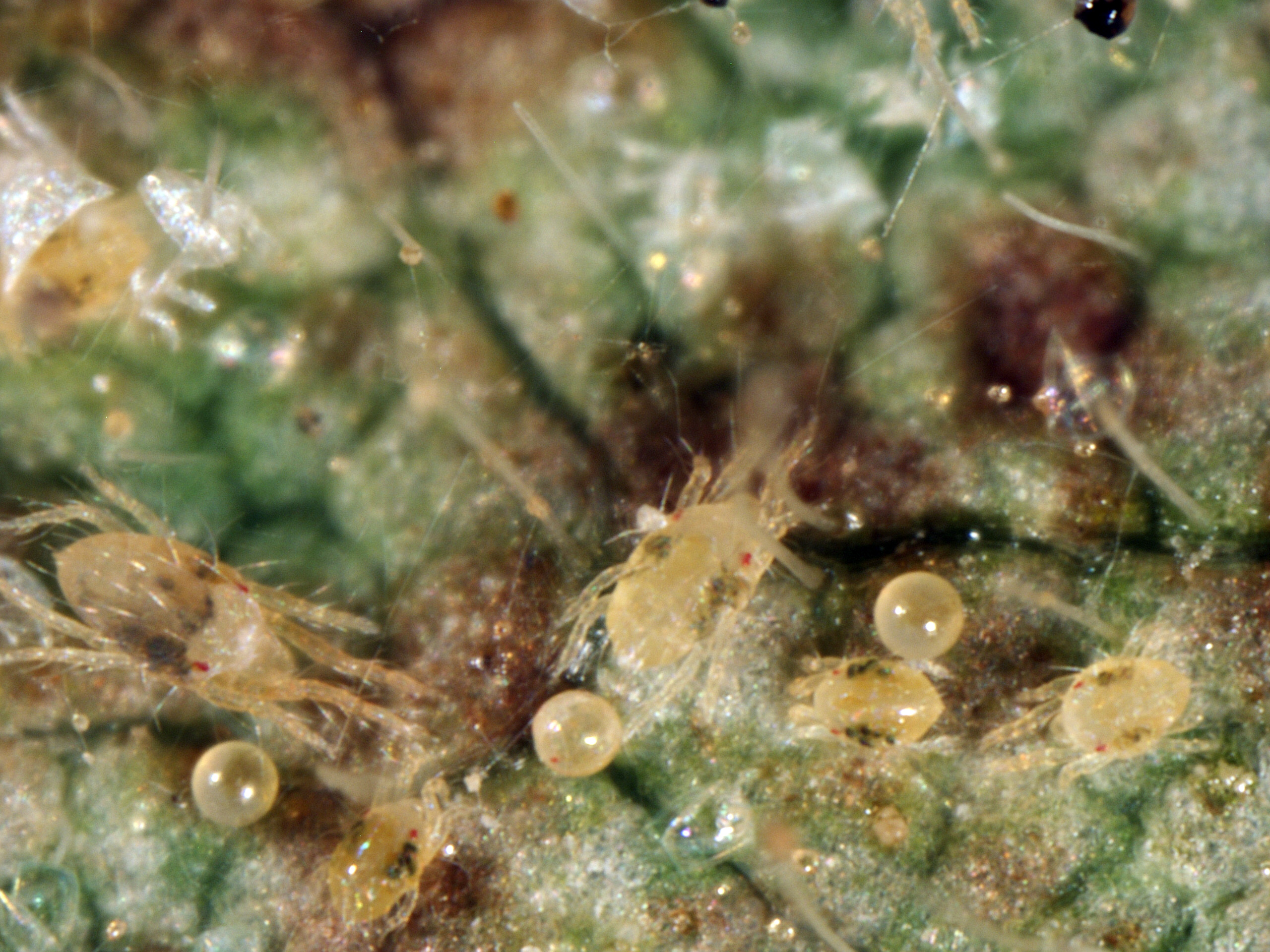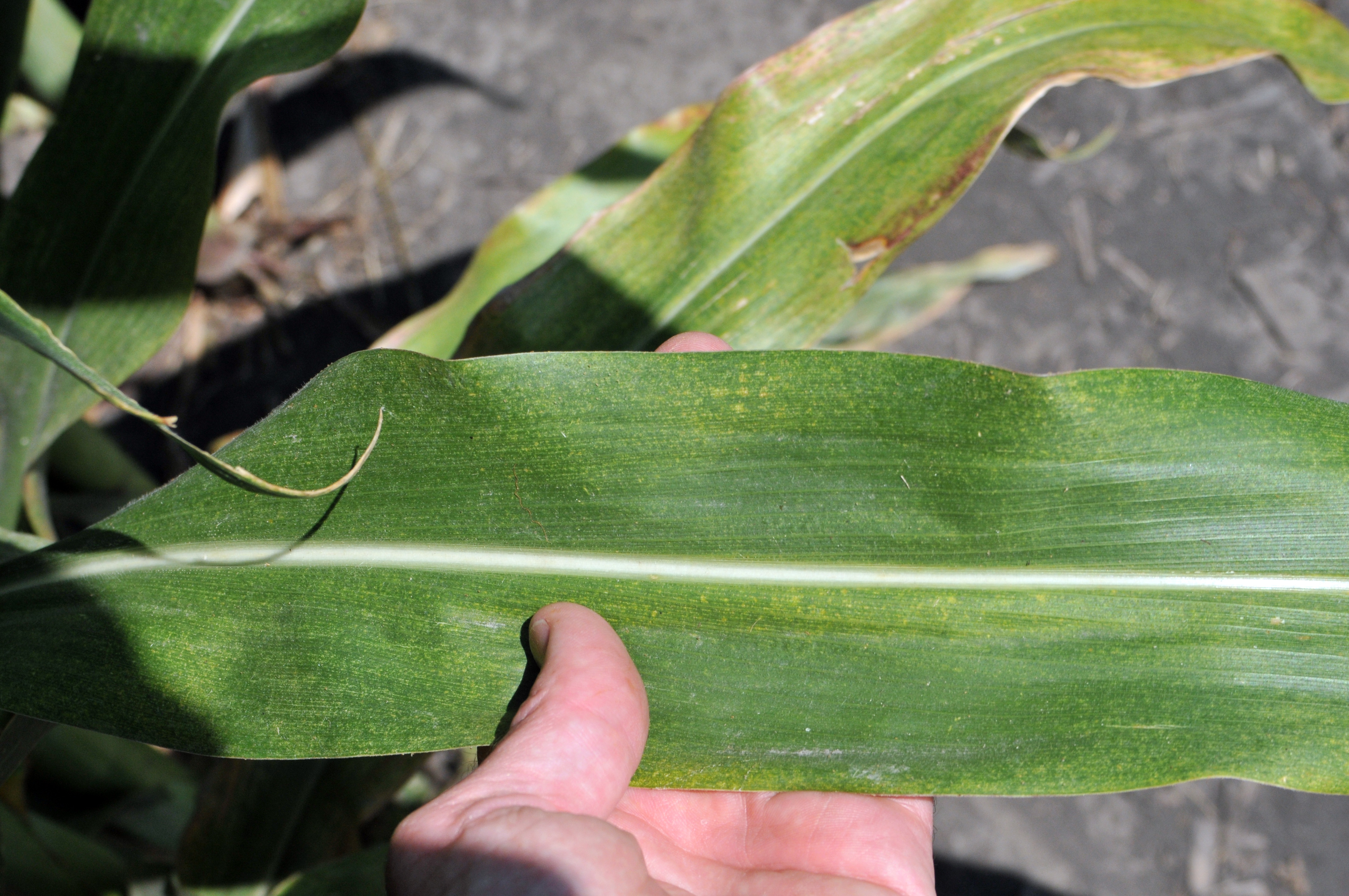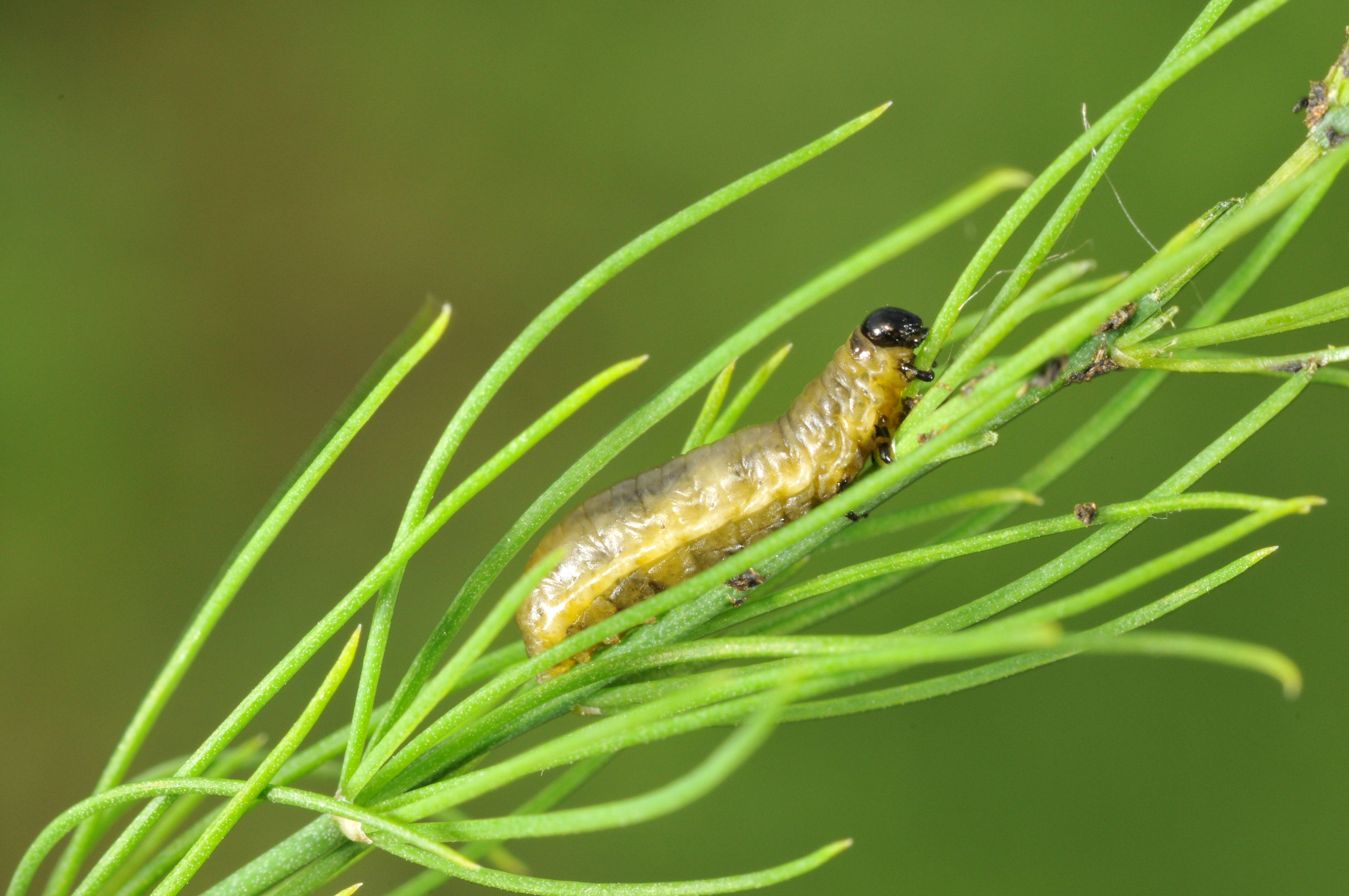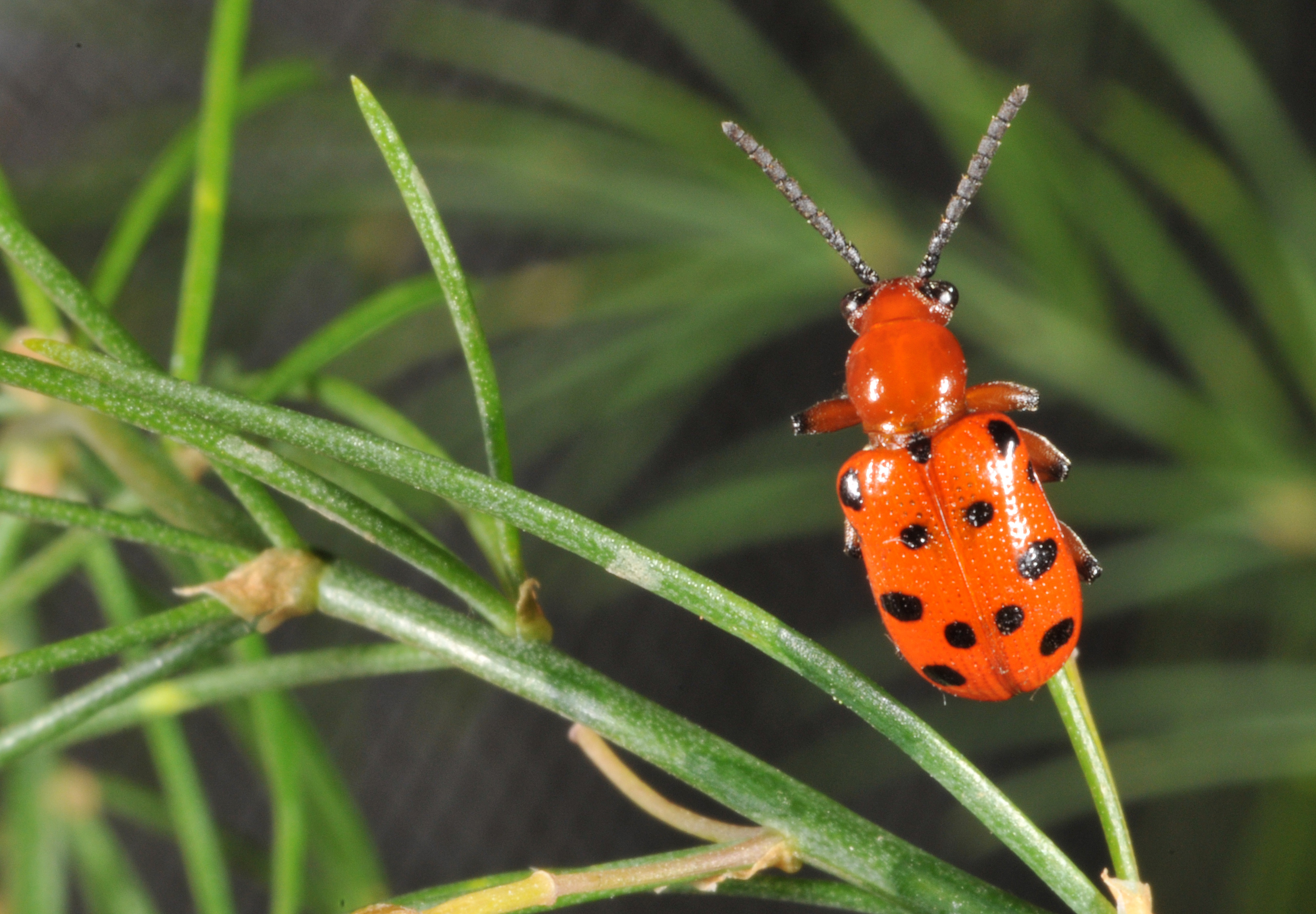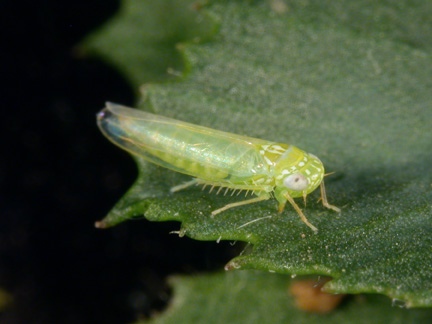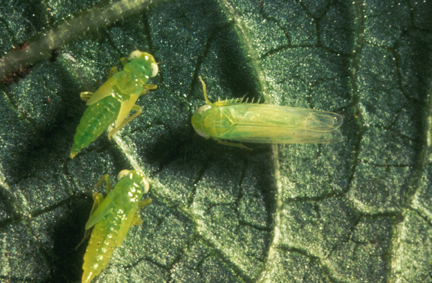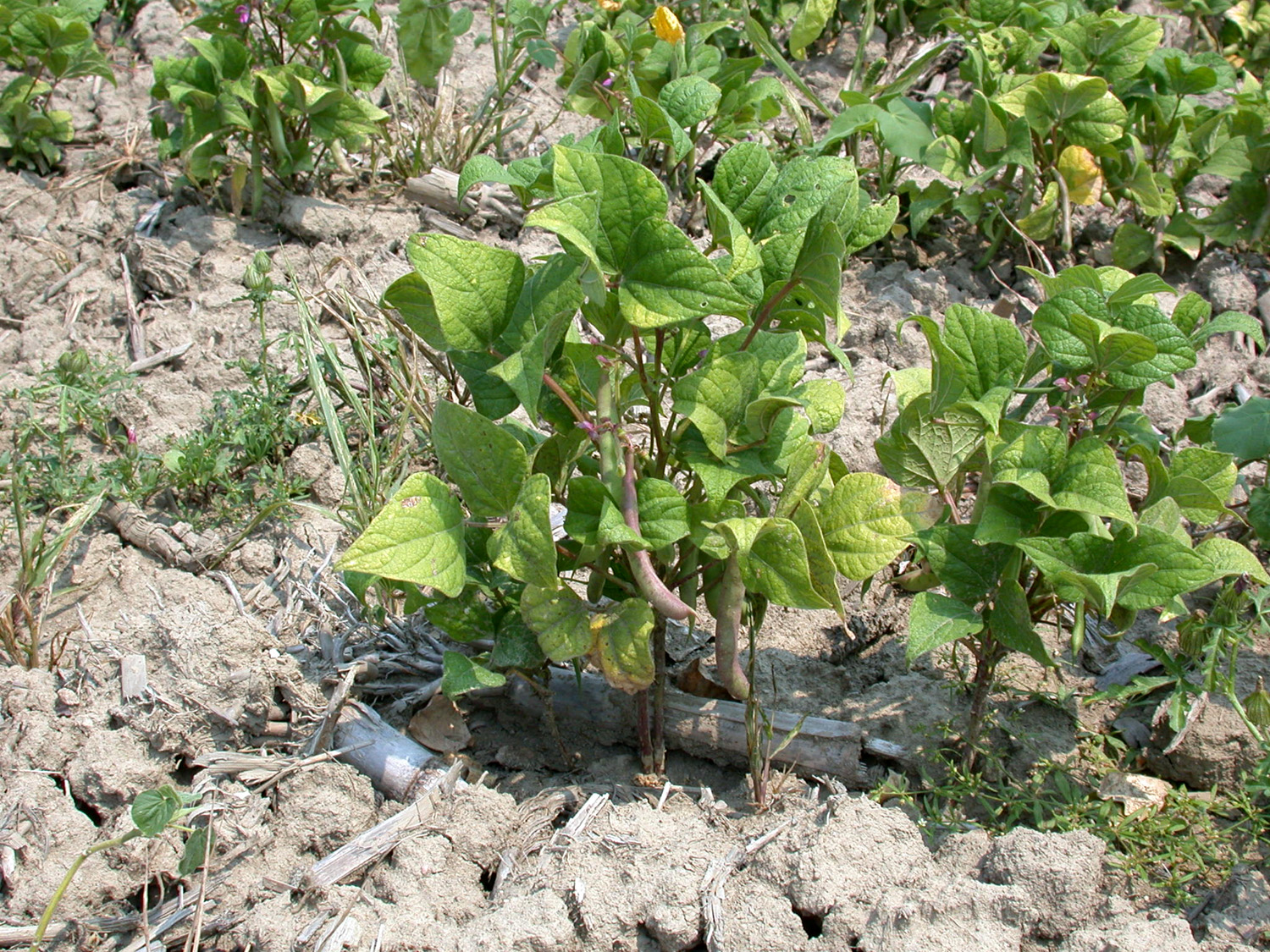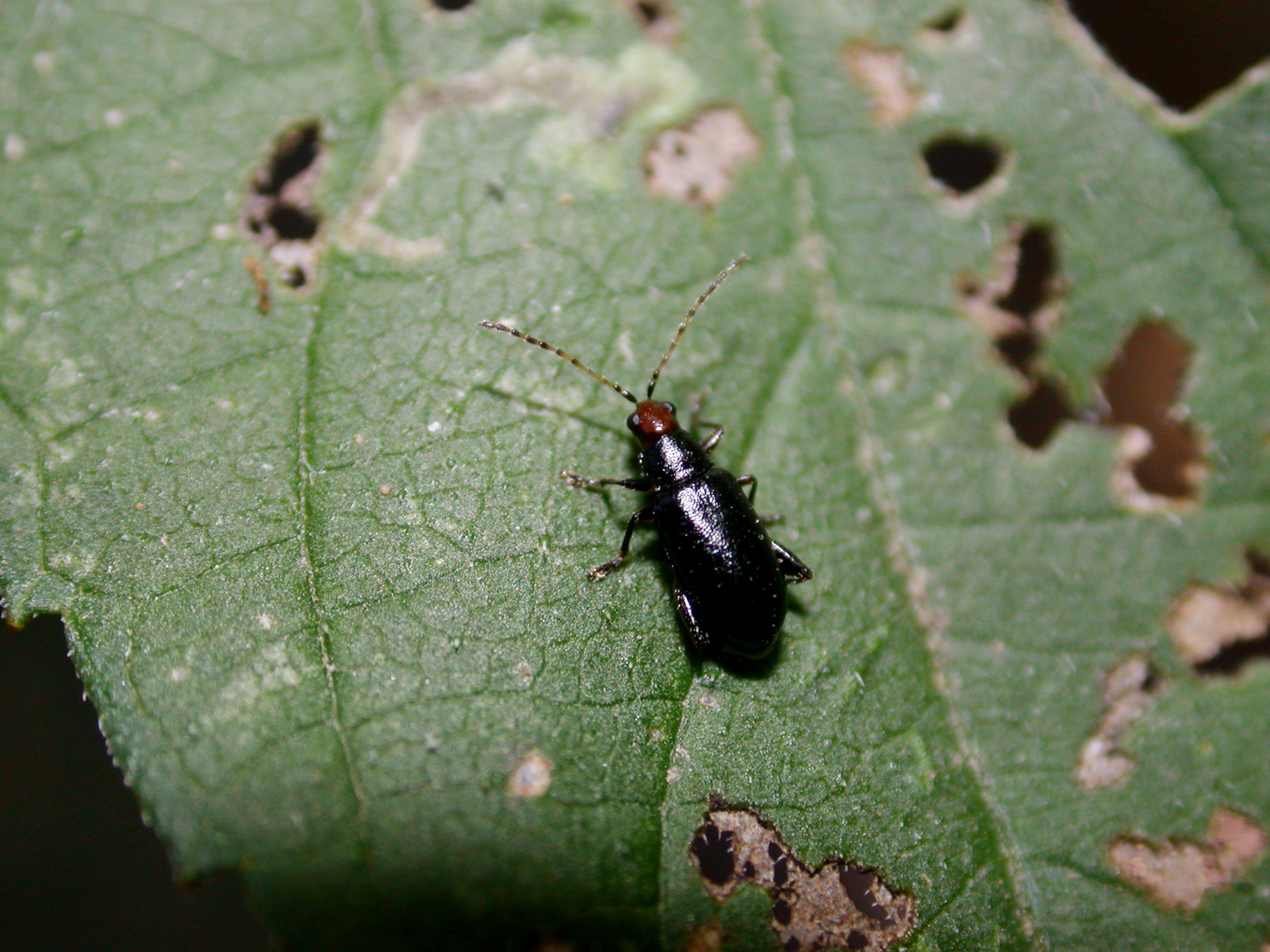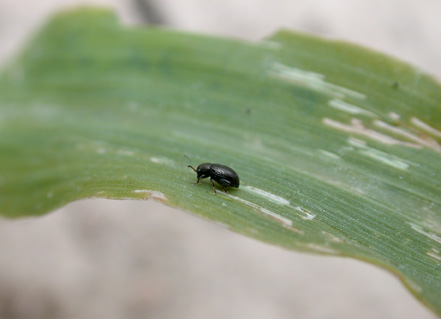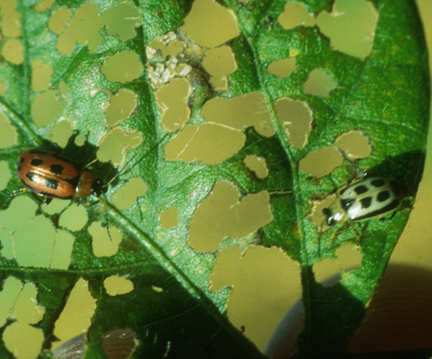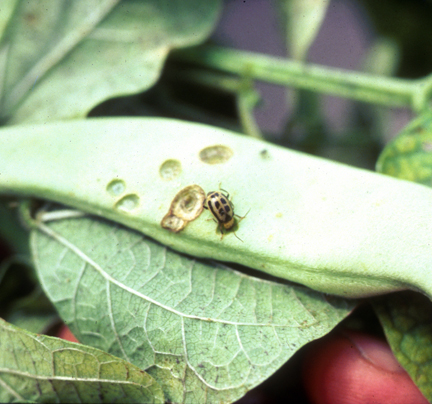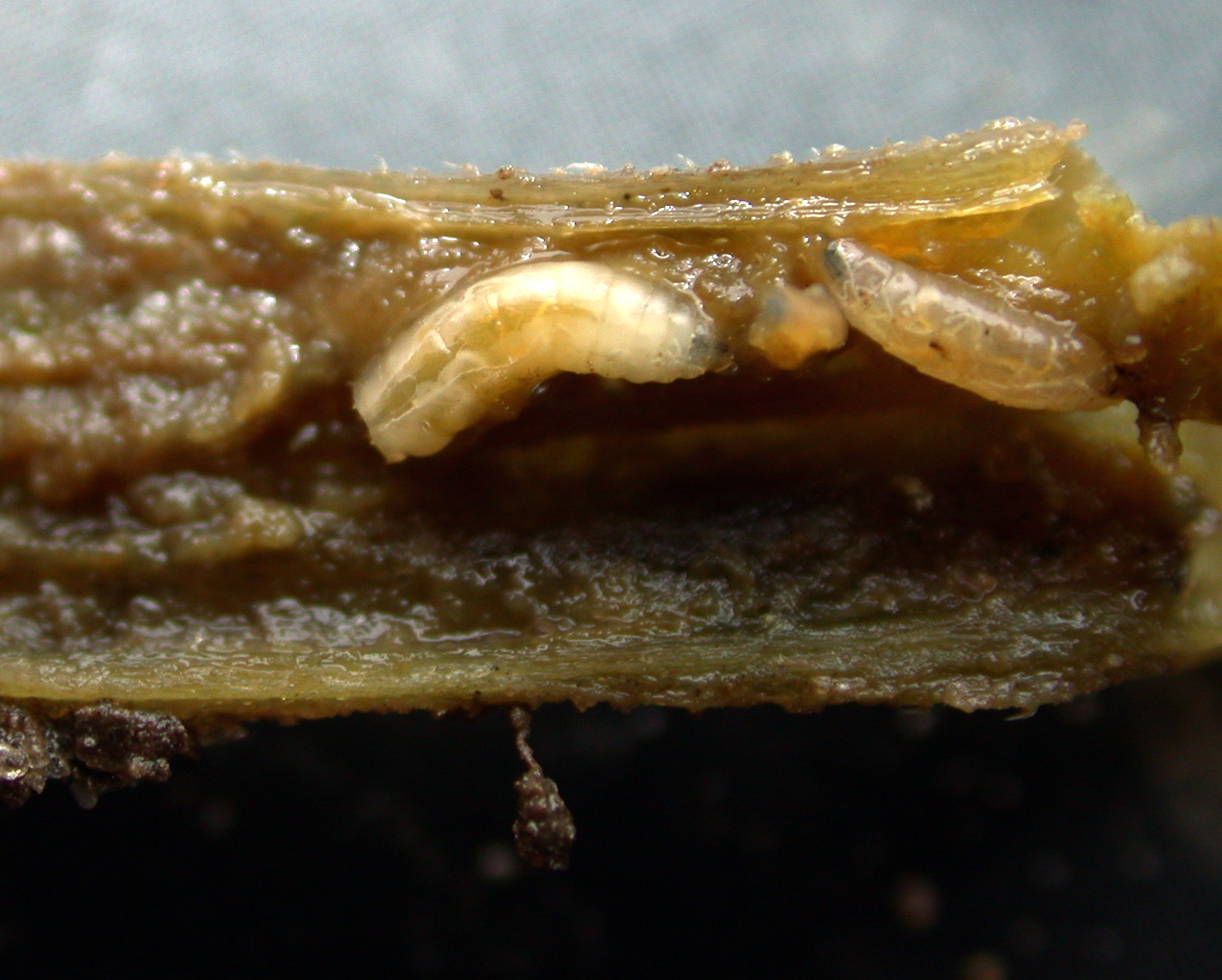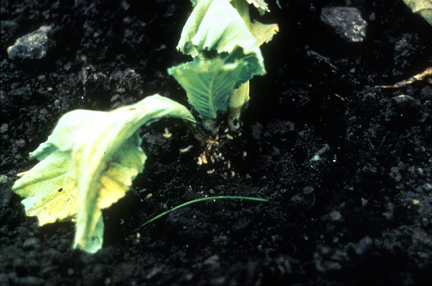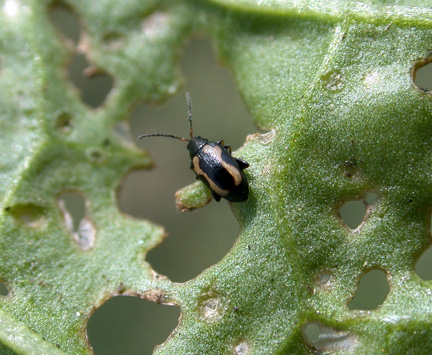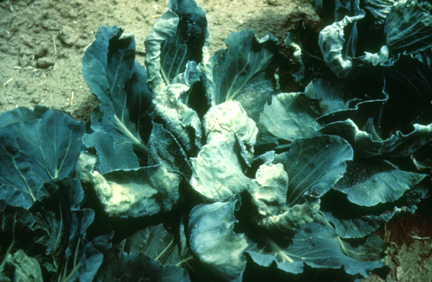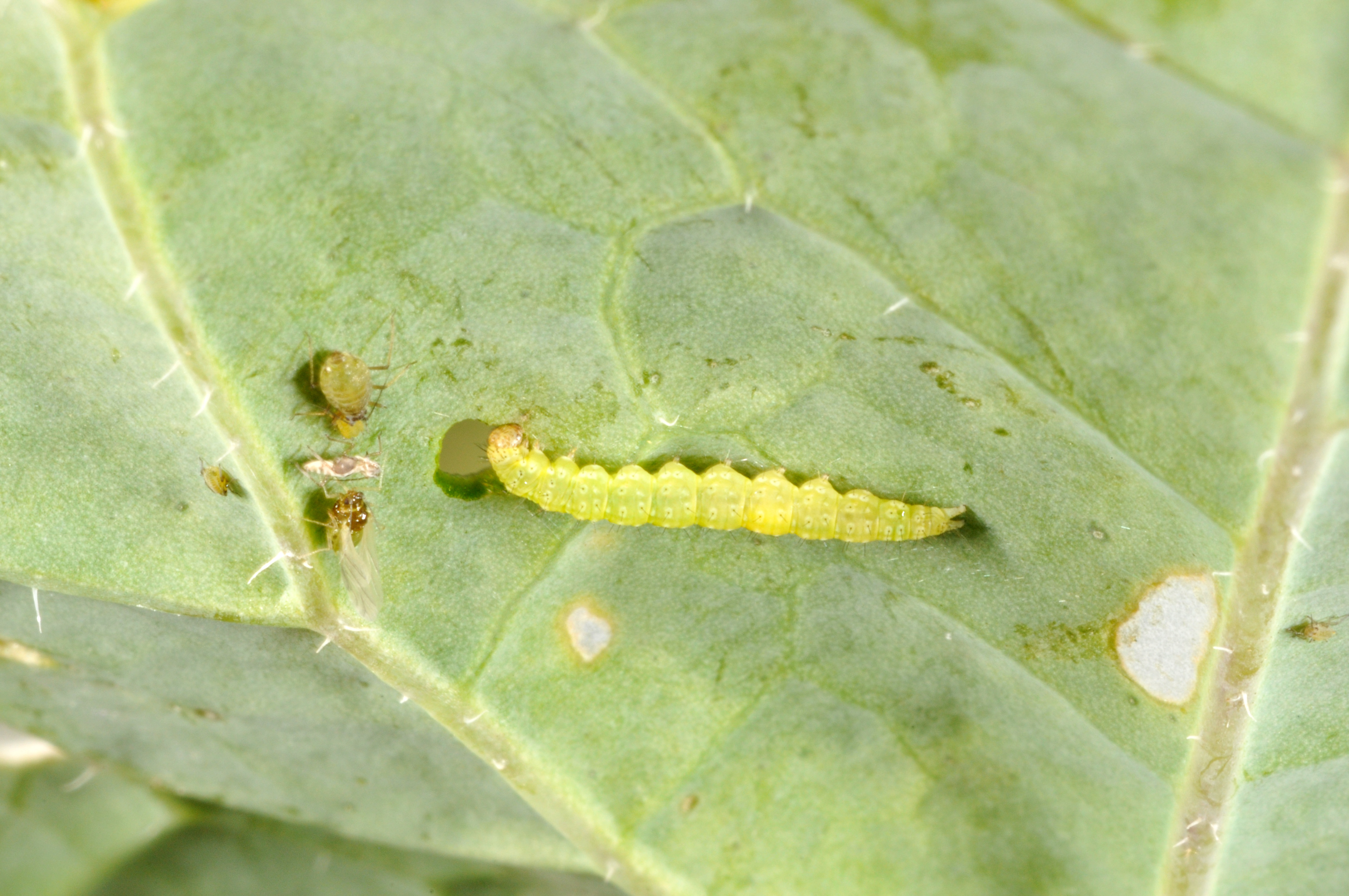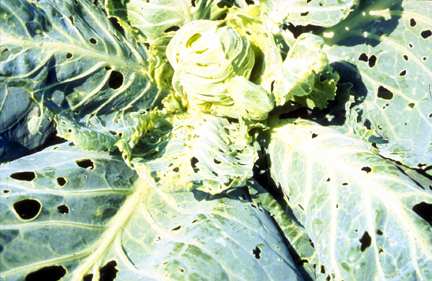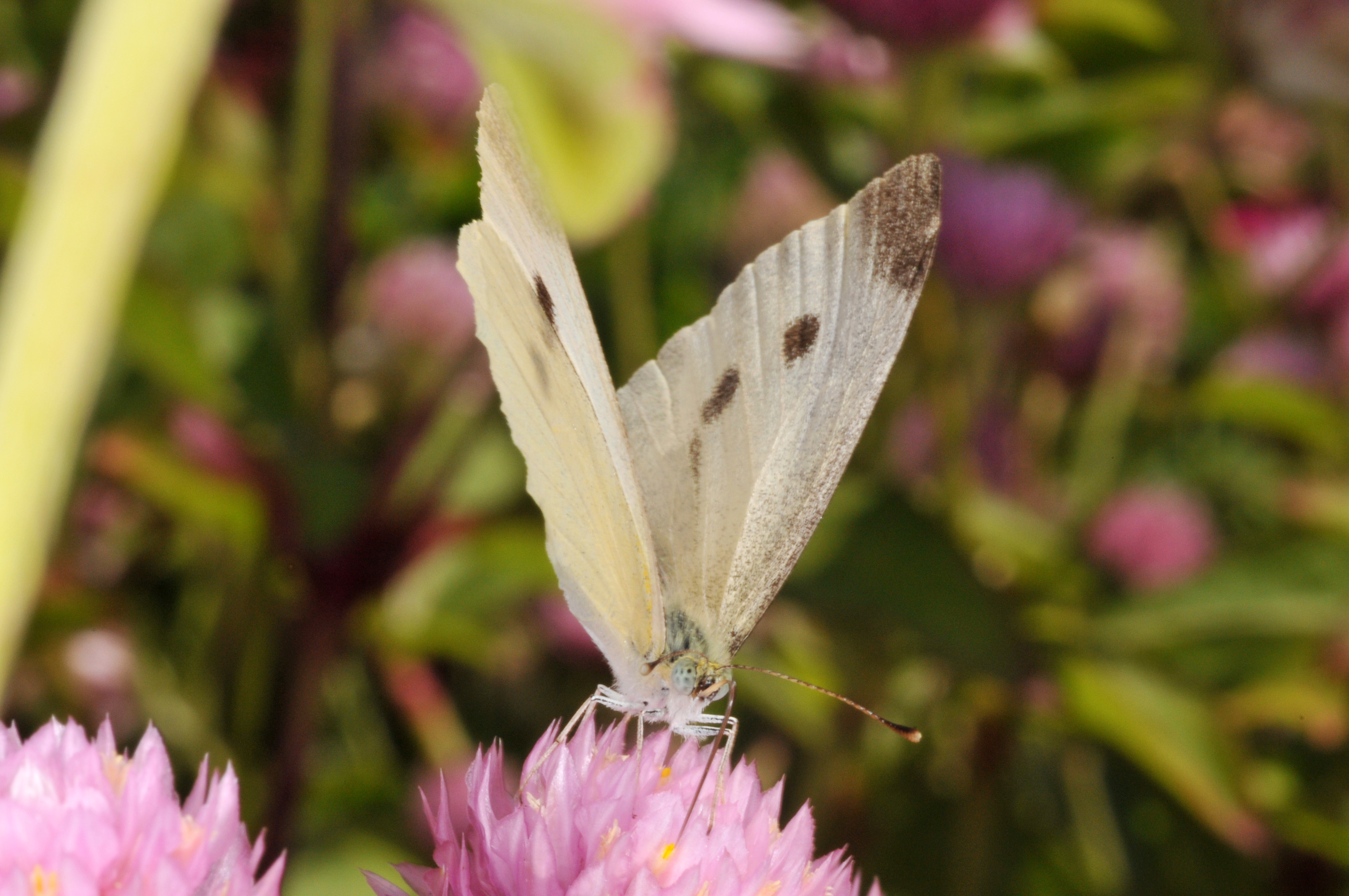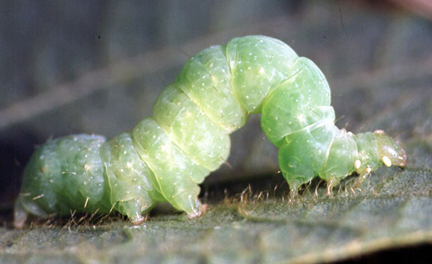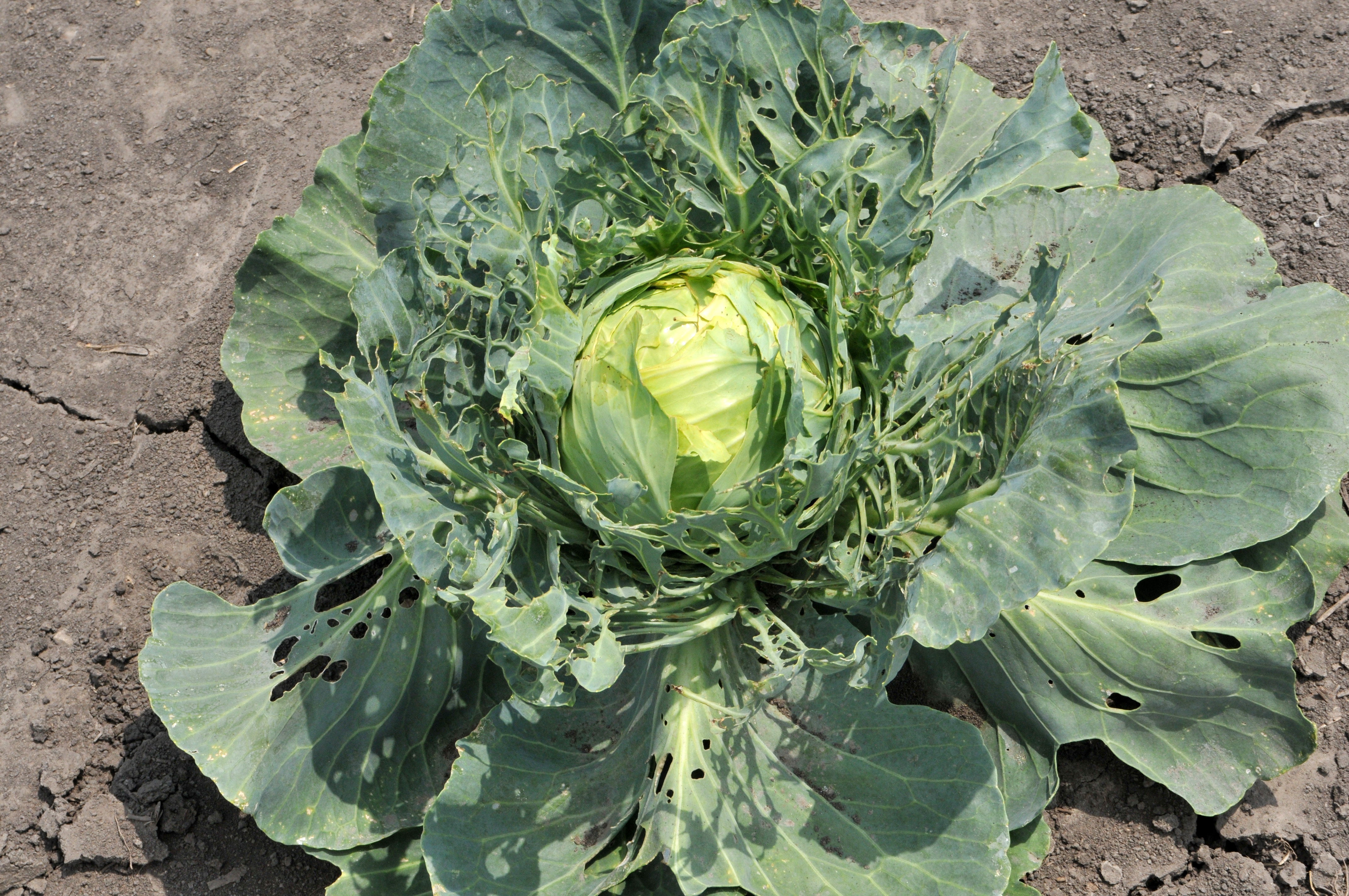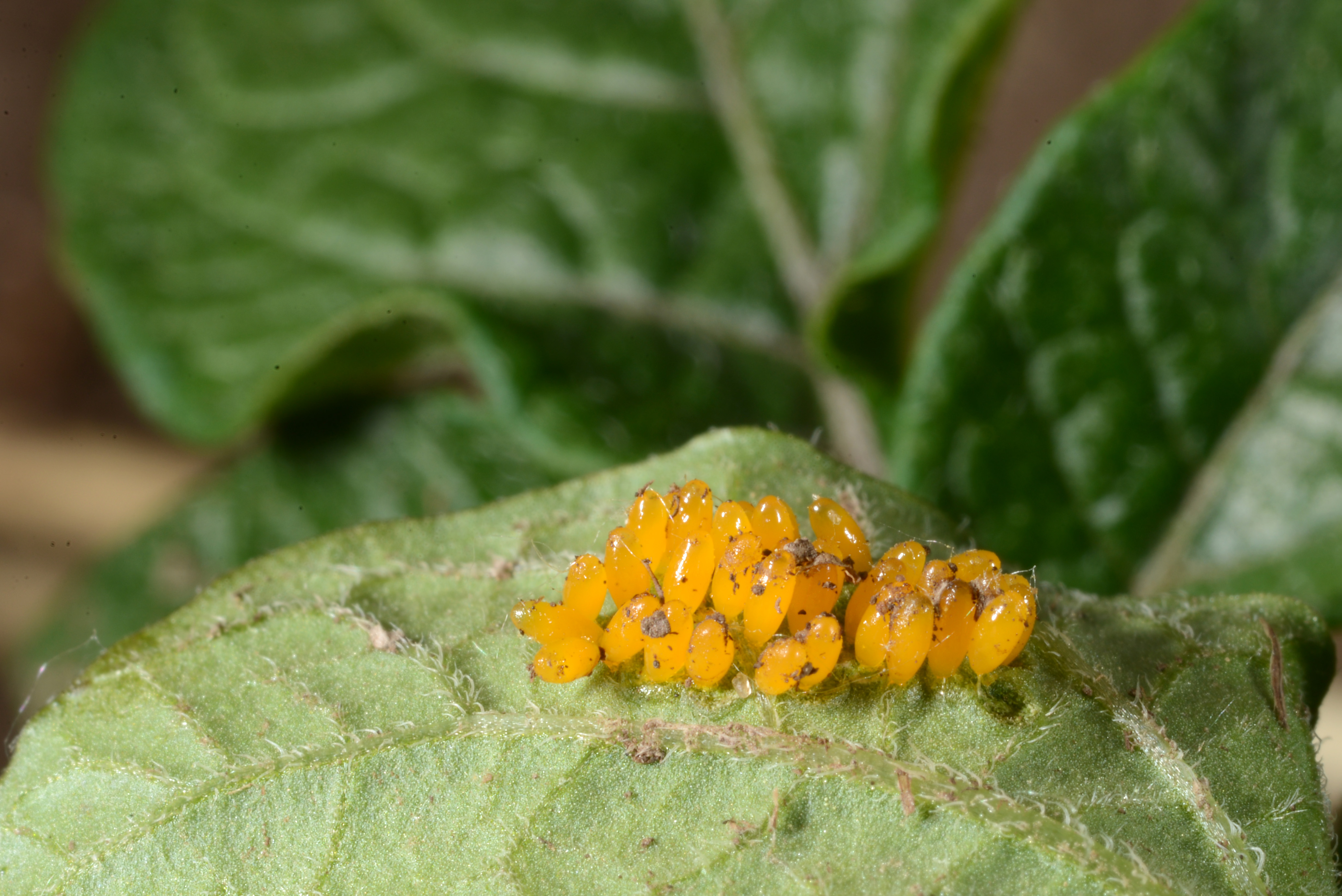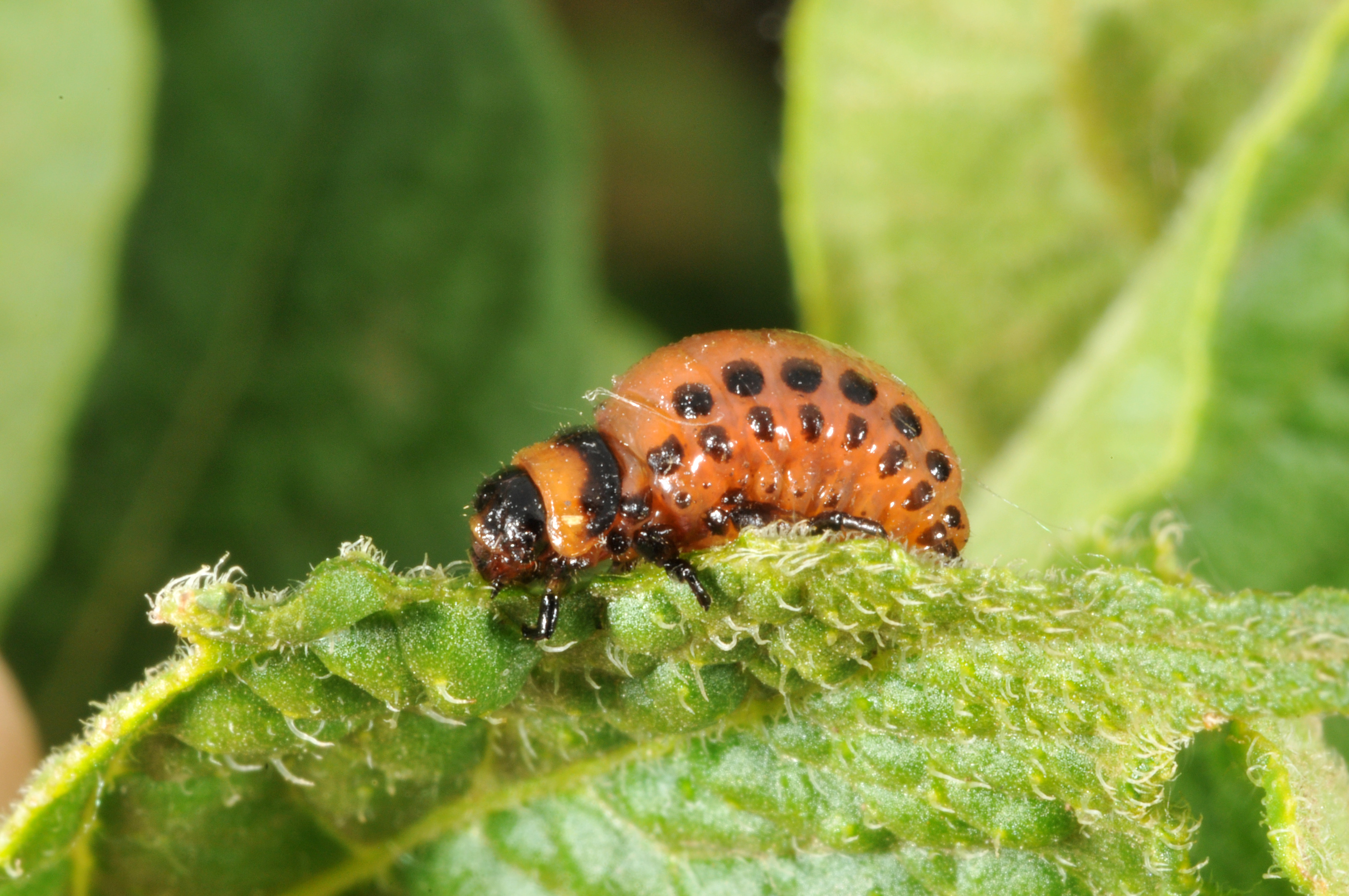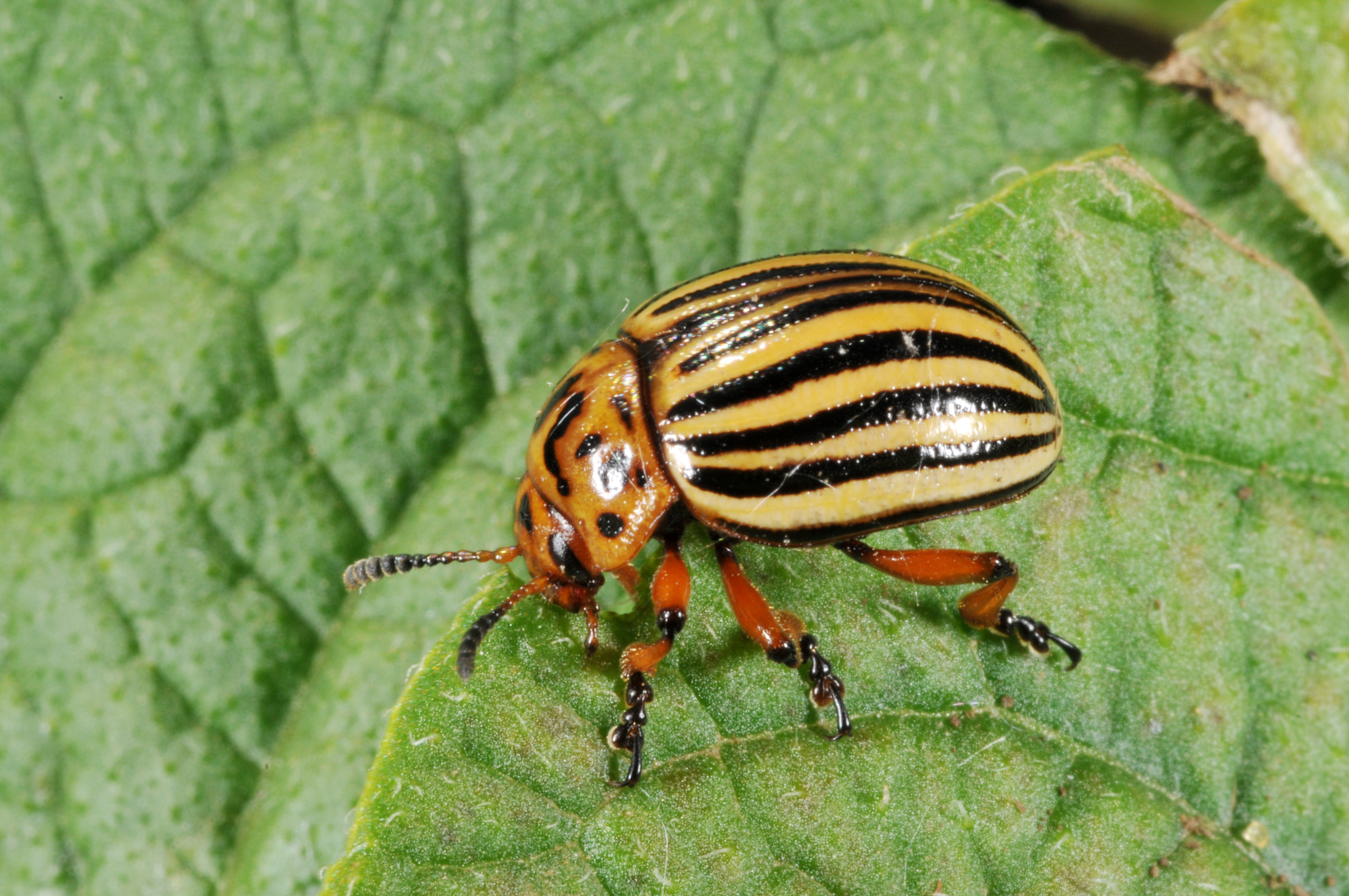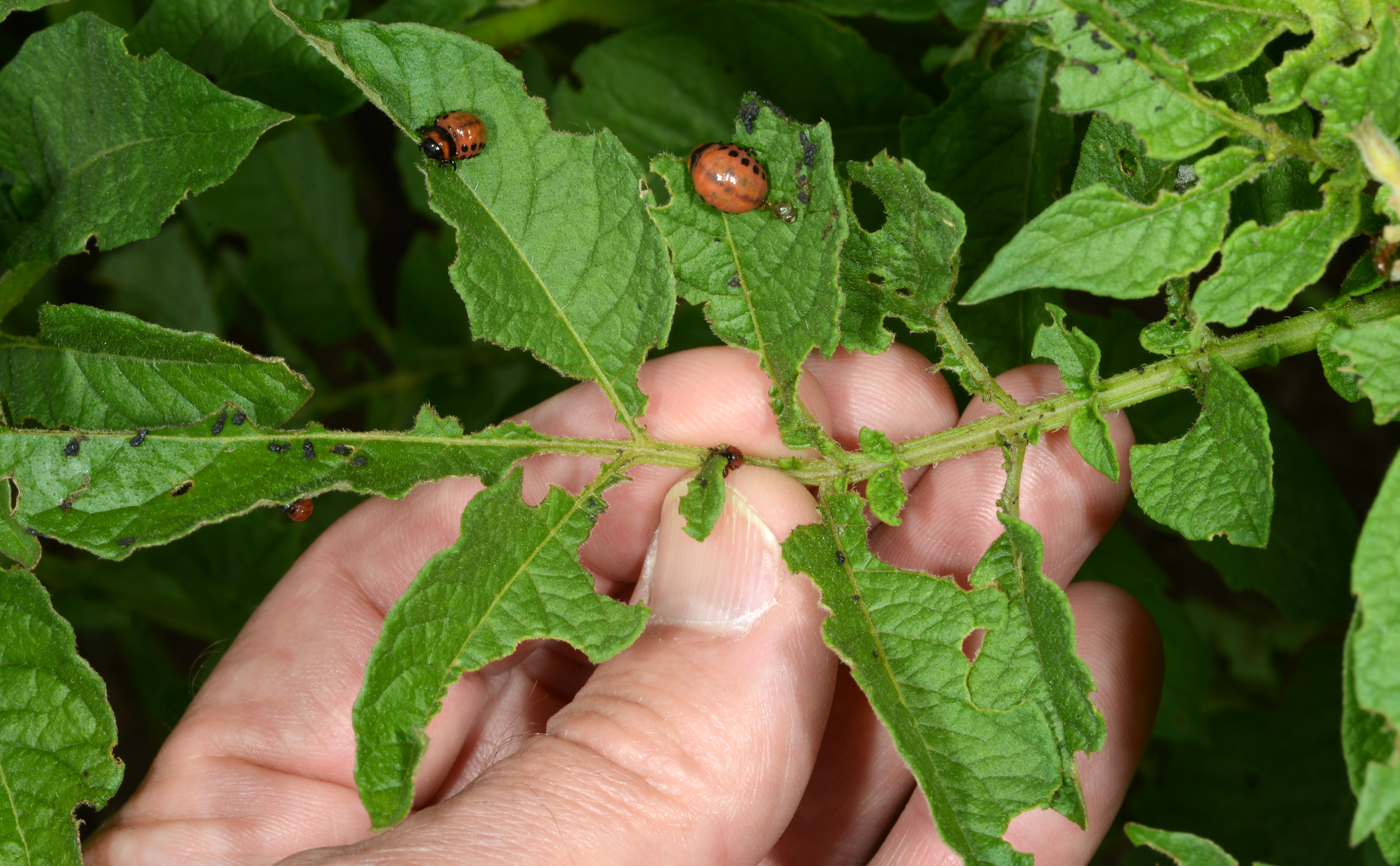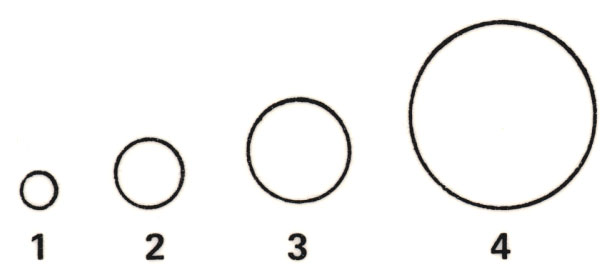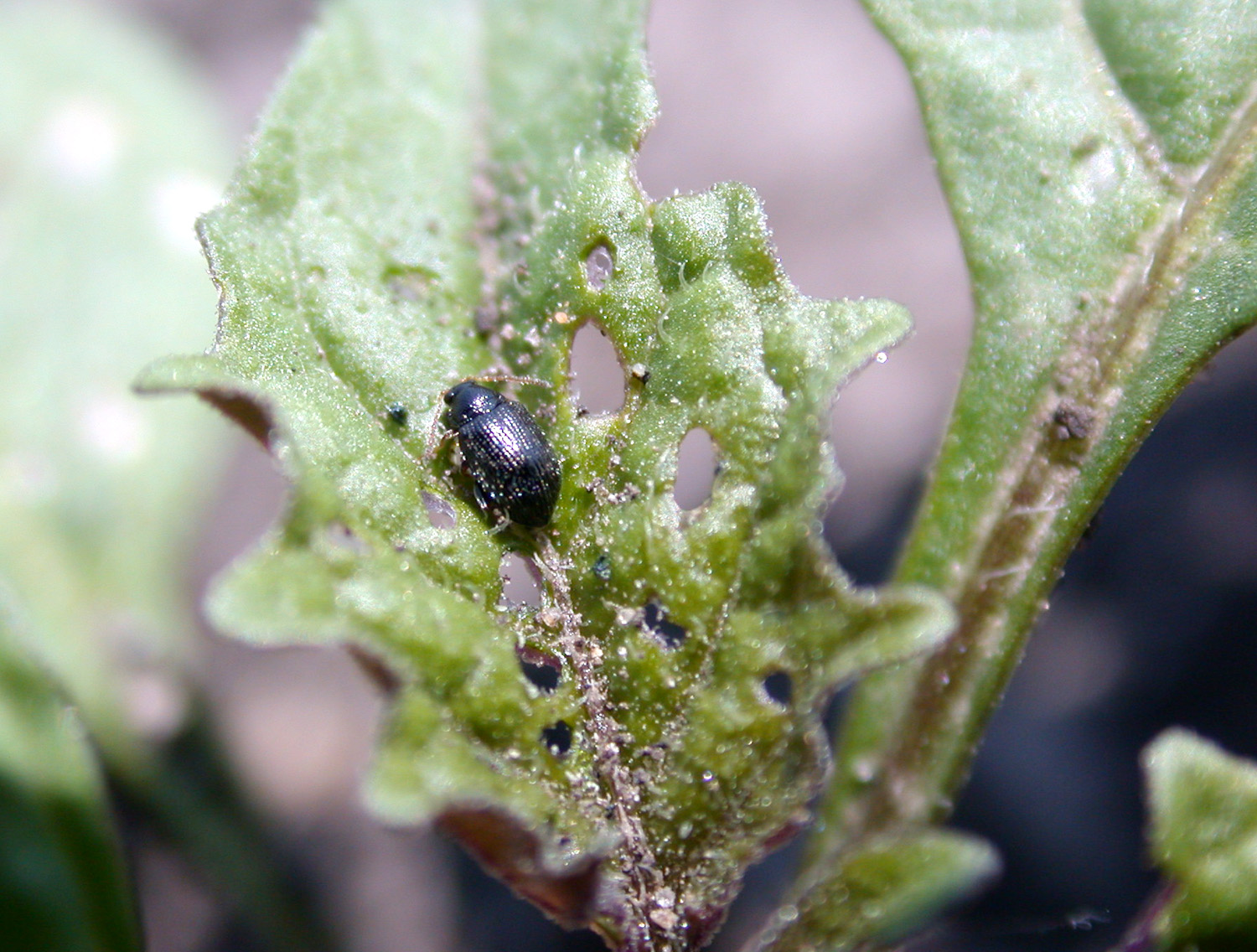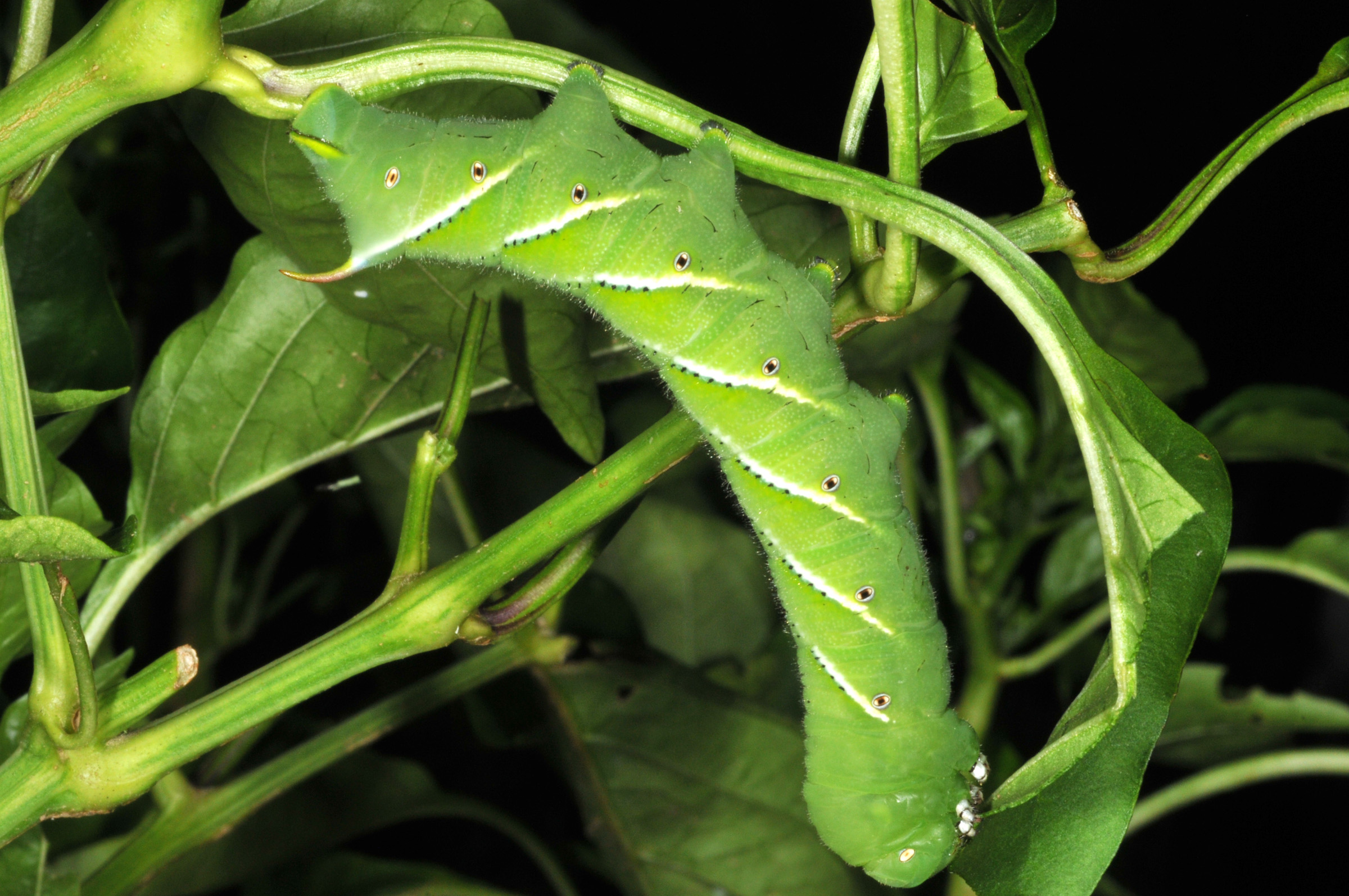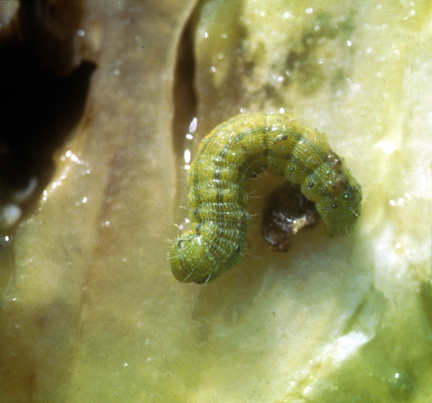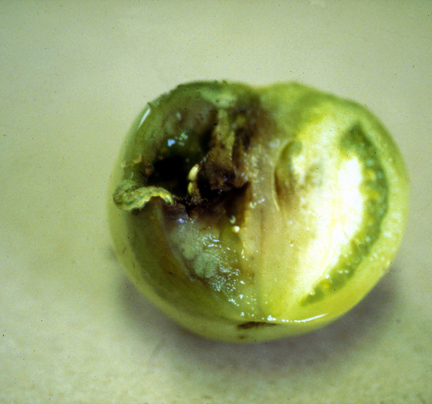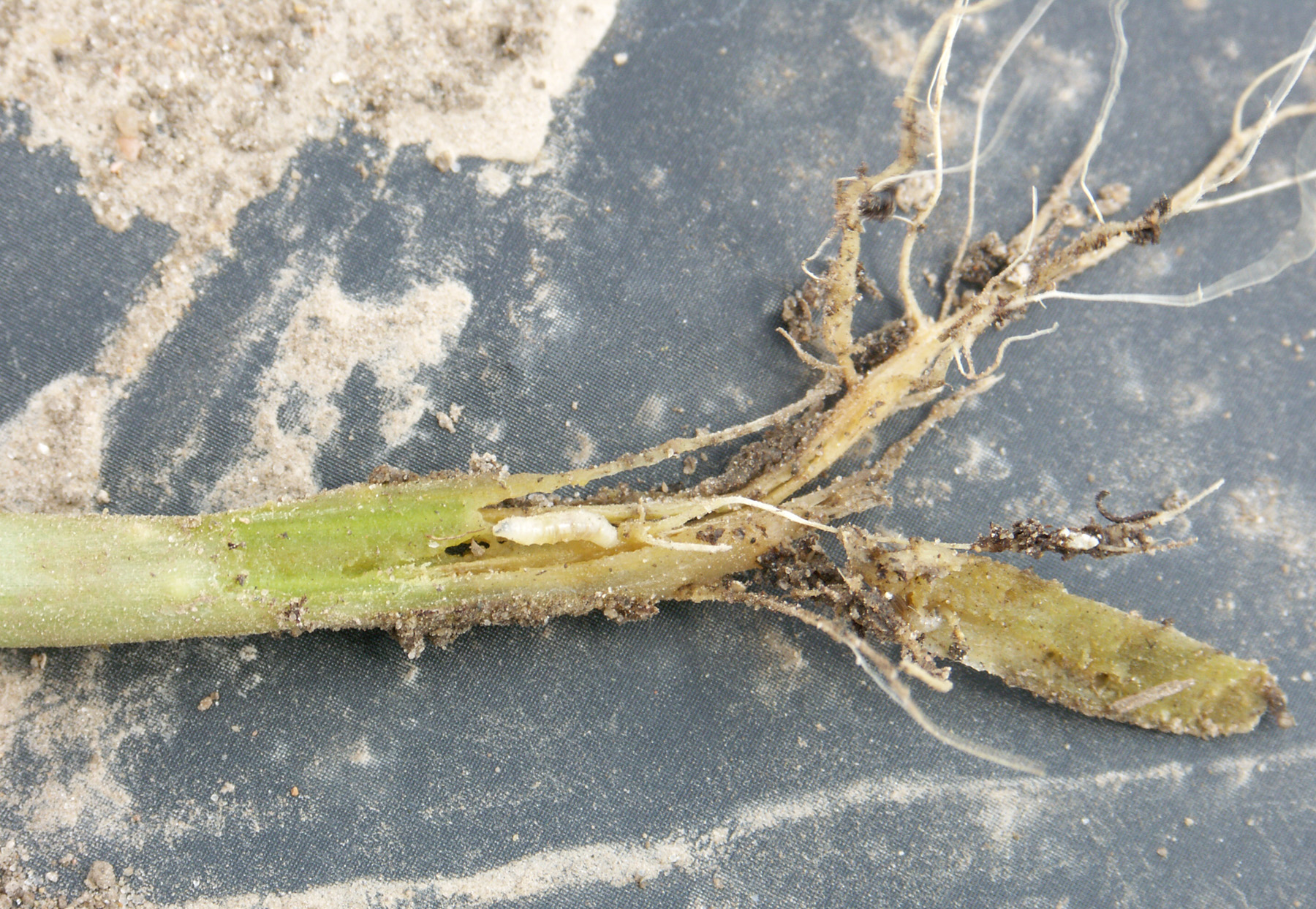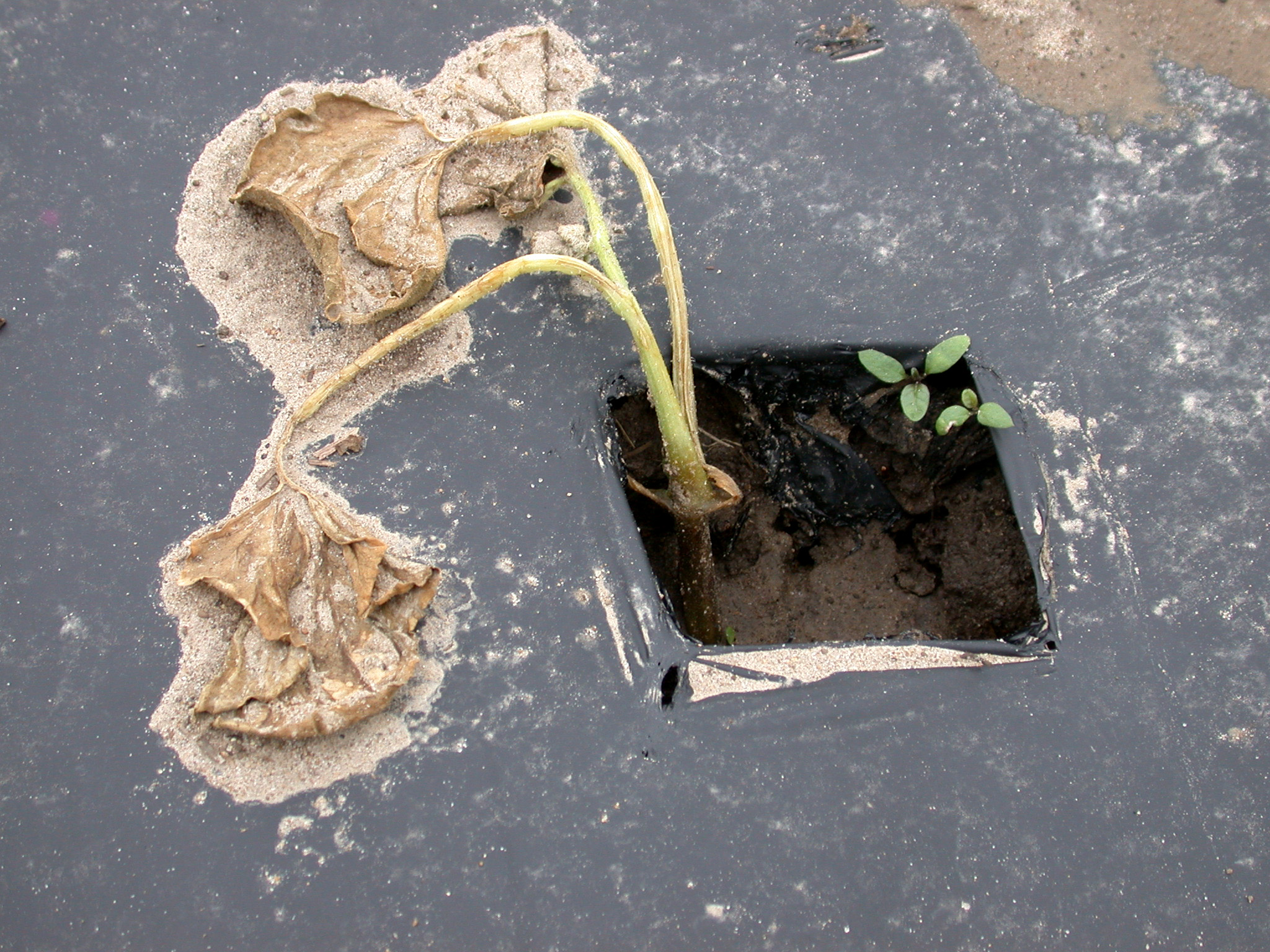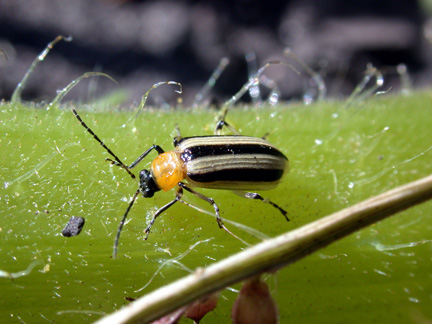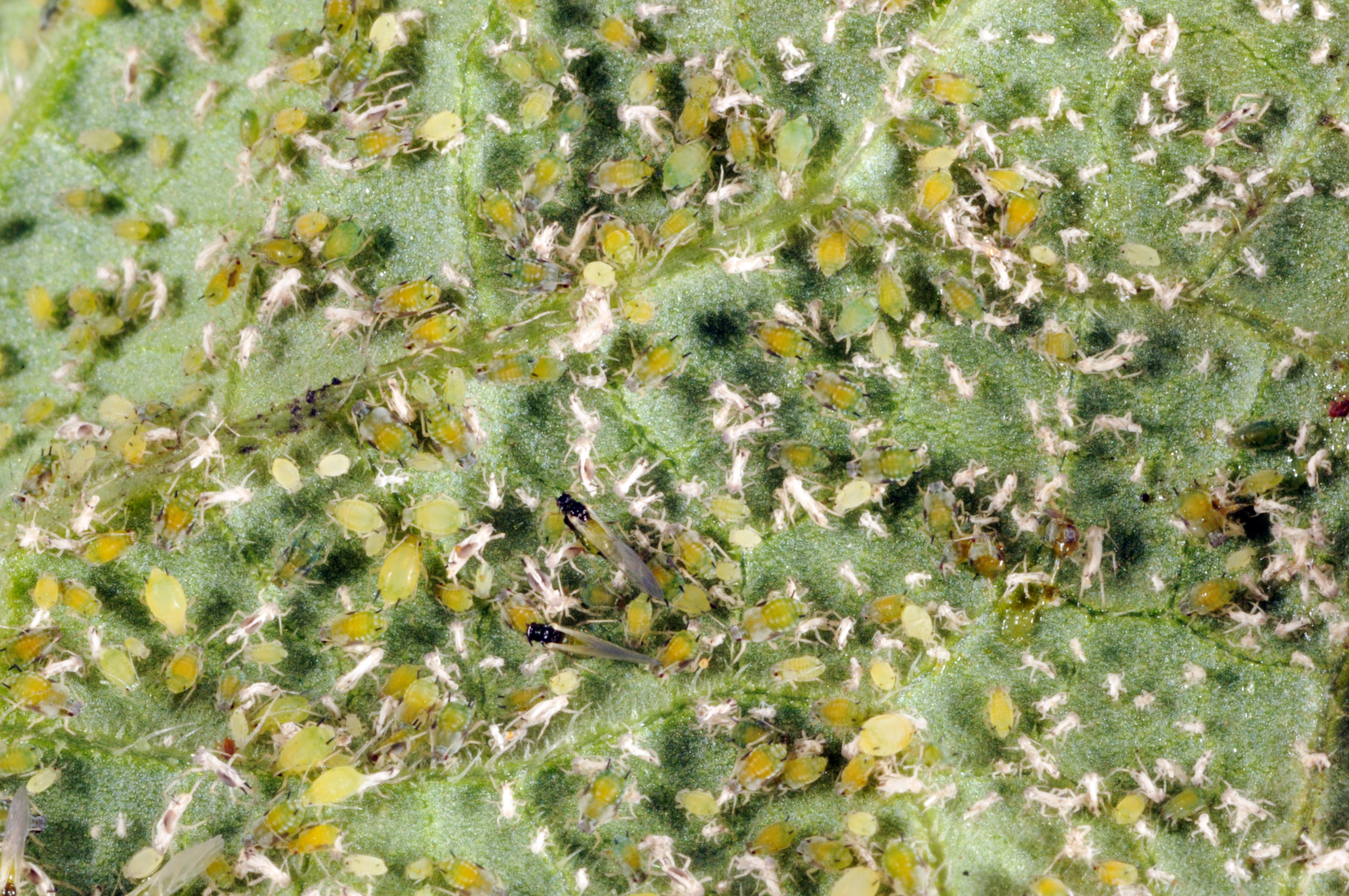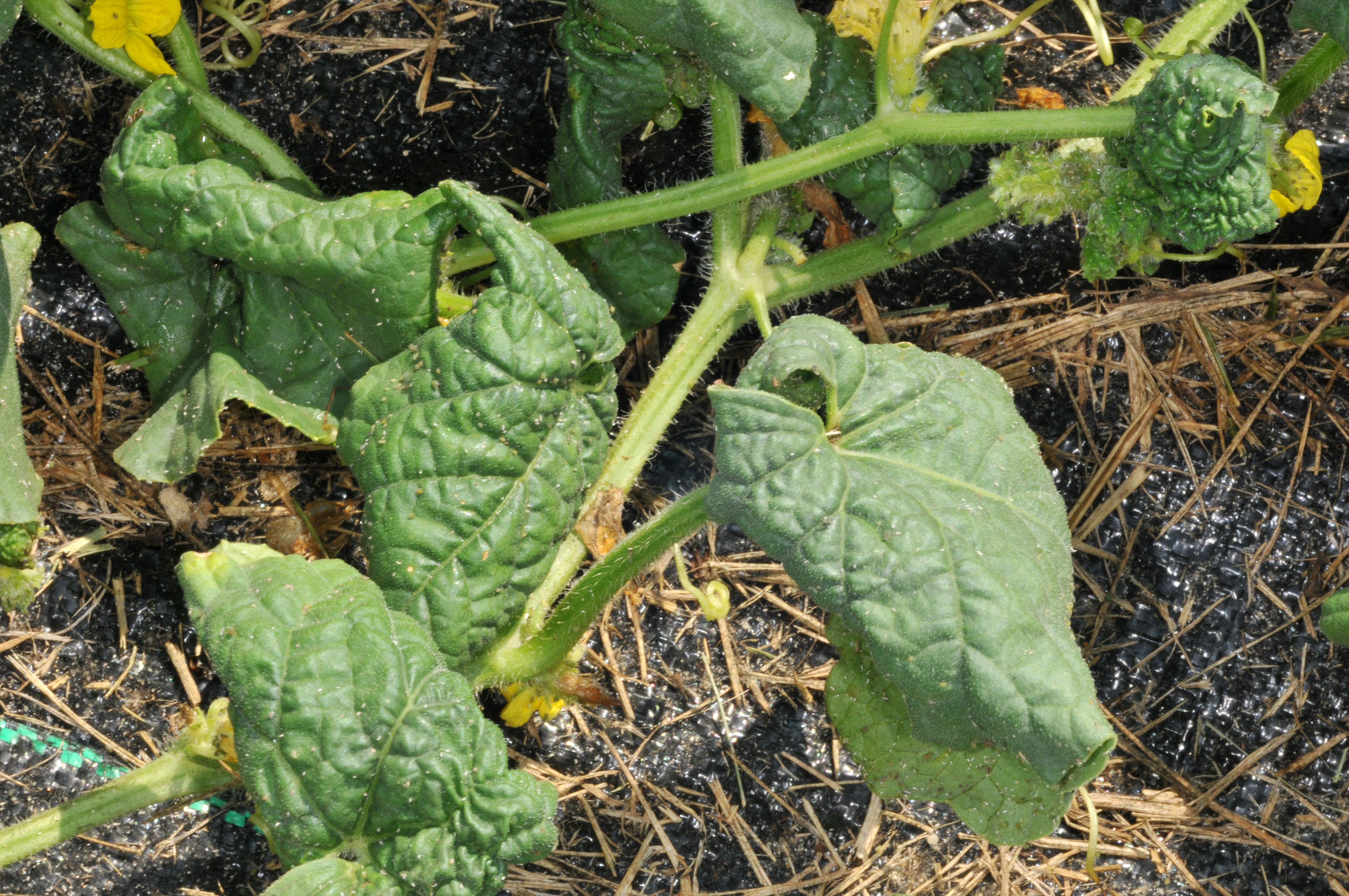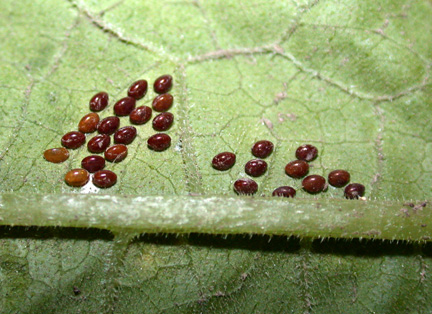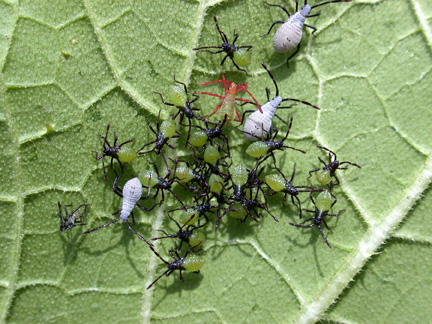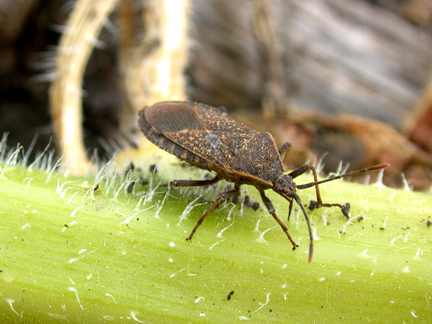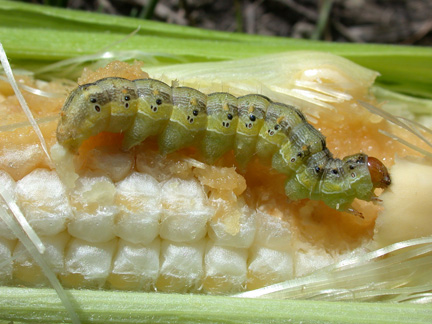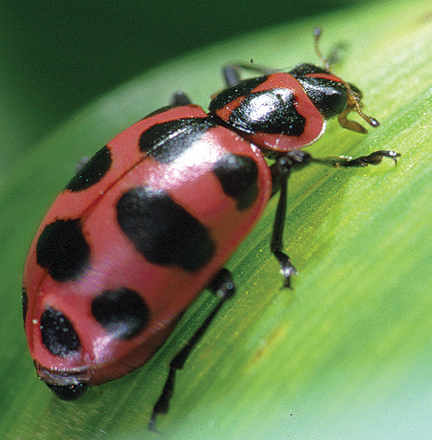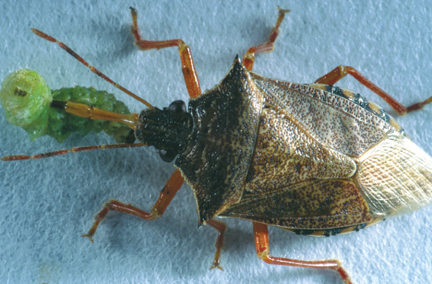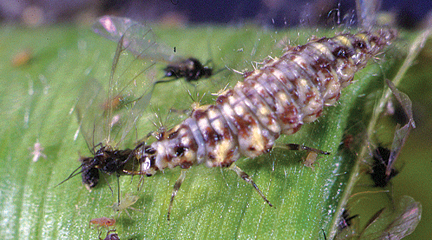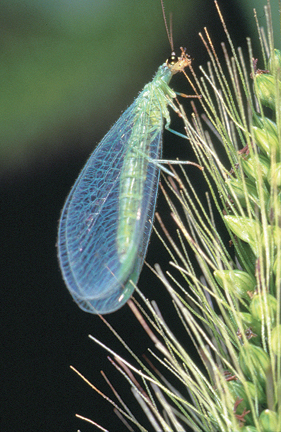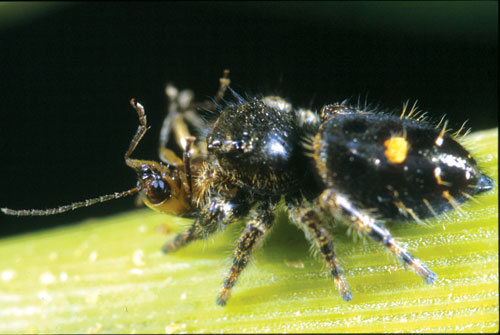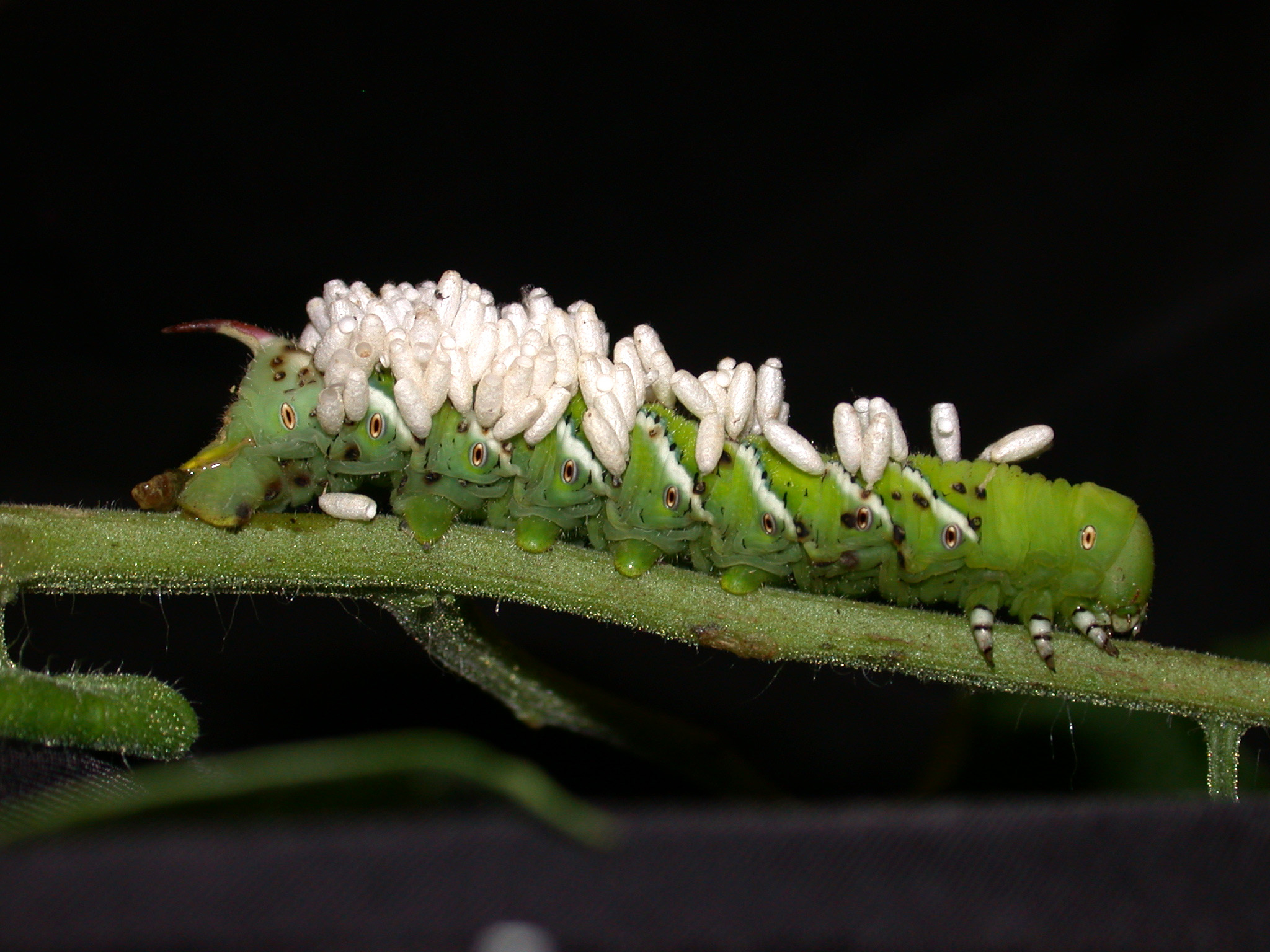Vegetable Insects
MANAGING INSECTS IN THE HOME VEGETABLE GARDEN
Rick E. Foster and John Obermeyer, Extension Entomologists
If you want to view as pdf, click here
Insects feeding on home-grown vegetables are a fact of life for most gardeners. Gardeners’ two choices are to tolerate the damage or attempt to prevent it. Frequently, tolerating the damage is a reasonable approach. For example, when tomatoes begin to ripen, most gardeners have more tomatoes than they can possibly use. So, caterpillars chewing on a few fruits are no real concern. Corn earworms usually confine their damage to the tips of sweet corn ears. A viable strategy is to cut off the damaged tips before cooking the corn.
Another approach is to plant crops less susceptible to injury from insect feeding. Table 1 categorizes vegetable crops as never or rarely, sometimes, and usually or always damaged by insects.
| Table 1. Frequency of Insect Damage to Various Vegetables Grown in the Home Garden |
|---|
| Never or Rarely |
|---|
| Beet |
| Carrot |
| Green Onion |
| Lettuce |
| Okra |
| Pea |
| Radish |
| Sometimes |
|---|
| Asparagus |
| Bean |
| Pepper |
| Spinach |
| Tomato |
| Watermelon |
| Usually or Always |
|---|
| Broccoli |
| Cabbage |
| Cantaloupe |
| Cauliflower |
| Cucumber |
| Eggplant |
| Potato |
| Squash/Pumpkin |
| Sweet Corn |
There are a number of practices that the home gardener can employ to reduce insect problems.
- Properly dispose of plant residues from the previous year’s garden.
- Plant varieties that are recommended for use in your area, and plant them at the proper time for best growth. Planting too early when the soil is cool may make the plants more susceptible to some soil insects.
- Inspect transplants before purchase to make sure they are healthy and not infested with insects.
- Use proper plant spacings, fertilizers, water, and cultural practices to insure vigorous plant growth. Plants that are growing vigorously often can tolerate more insect damage than poorly growing plants.
- Keep the garden as weed-free as possible. This will help the plants to continue to grow vigorously, and weeds may harbor insects that also will attack the vegetables. However, the presence of weeds or companion plants may increase the natural enemy population.
- Inspect plants regularly for insects or insect damage. Early detection means more effective control and can reduce the amount of damage suffered. Particularly in small gardens, early-detected caterpillars, loopers, hornworms, and large beetles can often be hand picked from plants and destroyed before they cause problems.
- Treat most vegetables with insecticides only when pest insects are observed; however, treat certain vegetables, such as cantaloupes, cucumbers, and squash, on a preventive basis to avoid serious damage.
- Consider the use of row covers to physically protect plants from insects, used early in the season, row covers can also provide some protection from frost. For vegetables that require pollinators, row covers need to be removed when flowers are present.
Row covers in a field.
(Photo credit: J. Obermeyer)
INSECTICIDES
Several types of insecticides are available for home gardeners. Table 2 lists the insects most commonly found on vegetables and the insecticides recommended to control them. The following sections describe the various types of available insecticides.
Botanical Insecticides (extracted from plants)
Neem: The active ingredient in Neem, azadirachtin, is derived from leaves or seeds of neem trees. It has activity against a variety of insect pests. For many pests, neem acts as a repellent, rather than a toxicant. Therefore, it is important to apply neem before a serious infestation is present.
Pyrethrum is derived from the flowers of certain chrysanthemums. It causes rapid paralysis and apparent death, but insects may subsequently recover. Pyrethrum provides control for up to 1 day and is most effective against soft-bodied insects such as scales and aphids.
Microbial Insecticides
Microbial insecticides available to the home gardener contain spores of the bacterium Bacillus thuringiensis (Bt), which paralyzes the insect’s gut after being eaten. A Bt strain effective against many caterpillars is sold as Dipel, Javelin, MVP, etc. Strains sold as M-Trak or Novodor are effective against the Colorado potato beetle. Microbial insecticides are not toxic to beneficial insects, humans, or other vertebrates. Spinosad is a relatively new fermentation product that has good activity against most caterpillars, Colorado potato beetles, and thrips.
Manufactured Insecticides
Carbaryl (Sevin) is a widely used insecticide with several trade names. It is effective on beetles and some caterpillars but does not kill aphids. Carbaryl is persistent on plants for 3-4 days, but may cause outbreaks of aphids and spider mites by killing natural enemies.
Malathion is moderately effective on a wide range of insects, especially sucking insects. It is persistent on plants for 2-3 days.
Several pyrethroid insecticides (bifenthrin, cyfluthrin, and permethrin) are available for homeowners to use on vegetables. These products are sold under a variety of trade names, so be sure to check the active ingredient on the label. The crops included on the label vary, so be sure that the crop you are treating is listed before you spray. All of the pyrethroids are extremely effective insecticides that will provide up to 7-10 days of control of a wide variety of pests. They will effectively control Colorado potato beetles that are resistant to insecticides such as Sevin. Pyrethroids are extremely toxic to fish, so caution should be used around bodies of water. Pyrethroids are also toxic to honey bees.
Neonicotinoids are a relatively new class of insecticides that control a wide variety of pests. Two neonicotinoids, acetamiprid, and imidacloprid are available for home gardeners. These products are systemic, which means the insecticide moves into and moves throughout the plant. These products cankill bees that feed on pollen of treated plants.
Spinosad is produced by fermenting a naturally occurring microorganism. It is available in organically approved formulations. This is a very safe product that controls a number of pests, including caterpillars and thrips.
Inorganic Insecticides (oils and soaps)
Horticultural oils work only on contact and have no residual activity. Commercially available insecticidal soaps, which are made from naturally occurring fatty acids, help control aphids, leafhoppers, mites, scales, and whiteflies. Like oils, soaps only control those organisms on which the spray lands.
Some Notes About Insecticides
- Although most insecticides available for use in the home garden are relatively safe to use, they are all POISONS and should be used with the utmost care. Carefully read and follow all precautions on the insecticide label. Table 3 lists the number of days you must wait after treatment before harvesting the vegetables. Vegetables should be thoroughly washed before they are eaten or cooked.
- Sometimes using an insecticide will increase insect problems. For example, overuse of carbaryl on some crops can increase problems with aphids, mites, and whiteflies because it kills the natural enemies that eat those pests, but does not kill the pests themselves.
- When spraying, both upper and lower leaf surfaces must be treated. Sprayer pressure must be sufficient to roll leaves over. Aerosol cans of insecticide are not recommended except to treat individual plants or very small gardens. Unless otherwise noted on the material label, a gallon of spray will cover approximately 500 square feet or 200 feet of row.
- When used properly, the insecticides available for use by home gardeners will not leave sufficient residues on the produce to cause any adverse health effects. As an added precaution, gardeners should rinse any produce with clean water before consuming it. This will also help wash away dirt and other debris. DO NOT wash vegetables in soapy water. Soap can be difficult to remove and has not been tested for safety when consumed.
| Table 2. General Garden Pests Commonly Found on Vegetables and Recommended Insecticides to Control Them. |
|---|
| Pests | Vegetables Attacked | Recommended Insecticides* |
|---|---|---|
| Aphids | Many vegetables | 1, 3, 5, 6, 8, 10, 12, 13 |
| Asparagus beetle | Asparagus | 4, 11, 14 |
| Bean leaf beetle | Bean | 3, 4 |
| Blister beetle | Many vegetables | 3, 4, 10 |
| Cabbage looper | Cabbage, cauliflower, broccoli | 1, 2, 4, 5, 11, 14 |
| Colorado potato beetle | Potato, tomato, eggplant, pepper | 2, 3, 5, 11, 14 |
| Corn earworm/fruitworm | Corn, tomato, bean | 1, 2, 3, 4, 11, 14 |
| Cucumber beetle | Bean, cucumber, melon, squash, pumpkin | 3, 4, 5, 6, 12 |
| Cutworm | Many vegetables | 3, 4 bait, 5, 8, 11 |
| European corn borer | Corn, pepper, bean | 2, 3, 4, 5, 11, 14 |
| Flea beetle | Many vegetables | 1, 3, 4, 5, 6, 11 |
| Grasshopper | Many vegetables | 3, 5, 10, 11 |
| Imported cabbageworm | Cabbage, cauliflower, broccoli | 1, 2, 3, 5, 11, 14 |
| Japanese beetle | Many vegetables | 3, 4, 5, 10, 11 |
| Leafhopper | Bean, potato | 1, 3, 4, 5, 10, 11 |
| Mexican bean beetle | Bean | 3, 4, 5, 11 |
| Slugs | Many vegetables | 7, 9 |
| Squash bug | Cucumber, melon, squash, pumpkin | 3, 4, 5, 11 |
| Squash vine borer | Squash, pumpkin | 3, 4, 5, 11 |
| Tarnished plant bug | Many vegetables | 3, 4, 5, 8, 11, 12 |
| Tomato hornworm | Tomato, potato, eggplant, pepper | 2, 3, 4, 5, 11, 14 |
| Twospotted spider mite | Many vegetables | 3, 8 |
| Whitefly | Many vegetables | 1, 3, 10, 12, 13 |
|
| Table 3. Harvest Restrictions in DAYS for Common Vegetable Insecticides |
|---|
| Asparagus |
|---|
| Insecticide | Days After Treatment to Wait Until Harvest |
|---|---|
| Acetamiprid | NO |
| Bacillus thuringiensis | 0 |
| Bifenthrin | NO |
| Carbaryl | 1 |
| Cyfluthrin | NO |
| Imidacloprid | NO |
| Malathion | NO |
| Neem | 0 |
| Permethrin | NO |
| Pyrethrins | 0 |
| Spinosad | 60 |
| Soap | 0 | NO - Not legal for use on this crop |
| Bean |
|---|
| Insecticide | Days After Treatment to Wait Until Harvest |
|---|---|
| Acetamiprid | 7 |
| Bacillus thuringiensis | 0 |
| Bifenthrin | 3 |
| Carbaryl | 3 |
| Cyfluthrin | NO |
| Imidacloprid | 21 |
| Malathion | 1 |
| Neem | 0 |
| Permethrin | NO |
| Pyrethrins | 0 |
| Spinosad | 3 |
| Soap | 0 | NO - Not legal for use on this crop |
| Broccoli |
|---|
| Insecticide | Days After Treatment to Wait Until Harvest |
|---|---|
| Acetamiprid | 7 |
| Bacillus thuringiensis | 0 |
| Bifenthrin | 7 |
| Carbaryl | 3 |
| Cyfluthrin | 0 |
| Imidacloprid | 21 |
| Malathion | 2 |
| Neem | 0 |
| Permethrin | 1 |
| Pyrethrins | 0 |
| Spinosad | 1 |
| Soap | 0 | NO - Not legal for use on this crop |
| Cabbage |
|---|
| Insecticide | Days After Treatment to Wait Until Harvest |
|---|---|
| Acetamiprid | 7 |
| Bacillus thuringiensis | 0 |
| Bifenthrin | 7 |
| Carbaryl | 3 |
| Cyfluthrin | 0 |
| Imidacloprid | 21 |
| Malathion | * |
| Neem | 0 |
| Permethrin | 1 |
| Pyrethrins | 0 |
| Spinosad | 1 |
| Soap | 0 | NO - Not legal for use on this crop * Variable. Check label. |
| Cantaloupe |
|---|
| Insecticide | Days After Treatment to Wait Until Harvest |
|---|---|
| Acetamiprid | 0 |
| Bacillus thuringiensis | 0 |
| Bifenthrin | 3 |
| Carbaryl | 3 |
| Cyfluthrin | 0 |
| Imidacloprid | 21 |
| Malathion | 1 |
| Neem | 0 |
| Permethrin | NO |
| Pyrethrins | 0 |
| Spinosad | 3 |
| Soap | 0 | NO - Not legal for use on this crop |
| Carrot |
|---|
| Insecticide | Days After Treatment to Wait Until Harvest |
|---|---|
| Acetamiprid | NO |
| Bacillus thuringiensis | 0 |
| Bifenthrin | NO |
| Carbaryl | 7 |
| Cyfluthrin | 0 |
| Imidacloprid | 21 |
| Malathion | NO |
| Neem | 0 |
| Permethrin | NO |
| Pyrethrins | 0 |
| Spinosad | NO |
| Soap | 0 | NO - Not legal for use on this crop |
| Cauliflower |
|---|
| Insecticide | Days After Treatment to Wait Until Harvest |
|---|---|
| Acetamiprid | 7 |
| Bacillus thuringiensis | 0 |
| Bifenthrin | 7 |
| Carbaryl | 3 |
| Cyfluthrin | 0 |
| Imidacloprid | 21 |
| Malathion | 2 |
| Neem | 0 |
| Permethrin | 1 |
| Pyrethrins | 0 |
| Spinosad | 1 |
| Soap | 0 | NO - Not legal for use on this crop |
| Cucumber |
|---|
| Insecticide | Days After Treatment to Wait Until Harvest |
|---|---|
| Acetamiprid | 0 |
| Bacillus thuringiensis | 0 |
| Bifenthrin | 3 |
| Carbaryl | 3 |
| Cyfluthrin | 0 |
| Imidacloprid | 21 |
| Malathion | 1 |
| Neem | 0 |
| Permethrin | NO |
| Pyrethrins | 0 |
| Spinosad | 1 |
| Soap | 0 | NO - Not legal for use on this crop |
| Eggplant |
|---|
| Insecticide | Days After Treatment to Wait Until Harvest |
|---|---|
| Acetamiprid | 7 |
| Bacillus thuringiensis | 0 |
| Bifenthrin | 7 |
| Carbaryl | 3 |
| Cyfluthrin | 7 |
| Imidacloprid | 21 |
| Malathion | NO |
| Neem | 0 |
| Permethrin | NO |
| Pyrethrins | 0 |
| Spinosad | 1 |
| Soap | 0 | NO - Not legal for use on this crop |
| Green onion |
|---|
| Insecticide | Days After Treatment to Wait Until Harvest |
|---|---|
| Acetamiprid | 7 |
| Bacillus thuringiensis | 0 |
| Bifenthrin | NO |
| Carbaryl | NO |
| Cyfluthrin | NO |
| Imidacloprid | NO |
| Malathion | NO |
| Neem | 0 |
| Permethrin | 14 |
| Pyrethrins | 0 |
| Spinosad | NO |
| Soap | 0 | NO - Not legal for use on this crop |
| Lettuce |
|---|
| Insecticide | Days After Treatment to Wait Until Harvest |
|---|---|
| Acetamiprid | 7 |
| Bacillus thuringiensis | 0 |
| Bifenthrin | 7 |
| Carbaryl | 14 |
| Cyfluthrin | 0 |
| Imidacloprid | 21 |
| Malathion | 14 |
| Neem | 0 |
| Permethrin | 1 |
| Pyrethrins | 0 |
| Spinosad | 1 |
| Soap | 0 | NO - Not legal for use on this crop |
| Okra |
|---|
| Insecticide | Days After Treatment to Wait Until Harvest |
|---|---|
| Acetamiprid | NO |
| Bacillus thuringiensis | 0 |
| Bifenthrin | NO |
| Carbaryl | 3 |
| Cyfluthrin | NO |
| Imidacloprid | 21 |
| Malathion | 1 |
| Neem | 0 |
| Permethrin | NO |
| Pyrethrins | 0 |
| Spinosad | 1 |
| Soap | 0 | NO - Not legal for use on this crop |
| Peas |
|---|
| Insecticide | Days After Treatment to Wait Until Harvest |
|---|---|
| Acetamiprid | 7 |
| Bacillus thuringiensis | 0 |
| Bifenthrin | 3 |
| Carbaryl | 3 |
| Cyfluthrin | NO |
| Imidacloprid | 21 |
| Malathion | 3 |
| Neem | 0 |
| Permethrin | NO |
| Pyrethrins | 0 |
| Spinosad | 3 |
| Soap | 0 | NO - Not legal for use on this crop |
| Pepper |
|---|
| Insecticide | Days After Treatment to Wait Until Harvest |
|---|---|
| Acetamiprid | 7 |
| Bacillus thuringiensis | 0 |
| Bifenthrin | 7 |
| Carbaryl | 3 |
| Cyfluthrin | 7 |
| Imidacloprid | 21 |
| Malathion | NO |
| Neem | 0 |
| Permethrin | NO |
| Pyrethrins | 0 |
| Spinosad | 1 |
| Soap | 0 | NO - Not legal for use on this crop |
| Potato |
|---|
| Insecticide | Days After Treatment to Wait Until Harvest |
|---|---|
| Acetamiprid | 7 |
| Bacillus thuringiensis | 0 |
| Bifenthrin | 21 |
| Carbaryl | 7 |
| Cyfluthrin | 0 |
| Imidacloprid | NO |
| Malathion | * |
| Neem | 0 |
| Permethrin | NO |
| Pyrethrins | 0 |
| Spinosad | 7 |
| Soap | 0 | NO - Not legal for use on this crop * Variable. Check Label. |
| Pumpkin |
|---|
| Insecticide | Days After Treatment to Wait Until Harvest |
|---|---|
| Acetamiprid | 0 |
| Bacillus thuringiensis | 0 |
| Bifenthrin | 3 |
| Carbaryl | 3 |
| Cyfluthrin | 0 |
| Imidacloprid | 21 |
| Malathion | NO |
| Neem | 0 |
| Permethrin | NO |
| Pyrethrins | 0 |
| Spinosad | 3 |
| Soap | 0 | NO - Not legal for use on this crop |
| Radish |
|---|
| Insecticide | Days After Treatment to Wait Until Harvest |
|---|---|
| Acetamiprid | NO |
| Bacillus thuringiensis | 0 |
| Bifenthrin | NO |
| Carbaryl | 7 |
| Cyfluthrin | 0 |
| Imidacloprid | 21 |
| Malathion | 7 |
| Neem | 0 |
| Permethrin | NO |
| Pyrethrins | 0 |
| Spinosad | NO |
| Soap | 0 | NO - Not legal for use on this crop |
| Spinach |
|---|
| Insecticide | Days After Treatment to Wait Until Harvest |
|---|---|
| Acetamiprid | 7 |
| Bacillus thuringiensis | 0 |
| Bifenthrin | NO |
| Carbaryl | 14 |
| Cyfluthrin | 0 |
| Imidacloprid | 21 |
| Malathion | 3 |
| Neem | 0 |
| Permethrin | NO |
| Pyrethrins | 0 |
| Spinosad | 1 |
| Soap | 0 | NO - Not legal for use on this crop |
| Squash |
|---|
| Insecticide | Days After Treatment to Wait Until Harvest |
|---|---|
| Acetamiprid | 0 |
| Bacillus thuringiensis | 0 |
| Bifenthrin | 3 |
| Carbaryl | 3 |
| Cyfluthrin | 0 |
| Imidacloprid | 21 |
| Malathion | 1 |
| Neem | 0 |
| Permethrin | 0 |
| Pyrethrins | 0 |
| Spinosad | 3 |
| Soap | 0 | NO - Not legal for use on this crop |
| Sweet corn |
|---|
| Insecticide | Days After Treatment to Wait Until Harvest |
|---|---|
| Acetamiprid | NO |
| Bacillus thuringiensis | 0 |
| Bifenthrin | 1 |
| Carbaryl | 2 |
| Cyfluthrin | 0 |
| Imidacloprid | NO |
| Malathion | NO |
| Neem | 0 |
| Permethrin | 21 |
| Pyrethrins | 0 |
| Spinosad | 1 |
| Soap | 0 | NO - Not legal for use on this crop |
| Tomato |
|---|
| Insecticide | Days After Treatment to Wait Until Harvest |
|---|---|
| Acetamiprid | 7 |
| Bacillus thuringiensis | 0 |
| Bifenthrin | 1 |
| Carbaryl | 3 |
| Cyfluthrin | 7 |
| Imidacloprid | 21 |
| Malathion | * |
| Neem | 0 |
| Permethrin | 5 |
| Pyrethrins | 0 |
| Spinosad | 1 |
| Soap | 0 | NO - Not legal for use on this crop * Variable. Check Label. |
| Watermelon |
|---|
| Insecticide | Days After Treatment to Wait Until Harvest |
|---|---|
| Acetamiprid | 0 |
| Bacillus thuringiensis | 0 |
| Bifenthrin | 3 |
| Carbaryl | 3 |
| Cyfluthrin | 0 |
| Imidacloprid | 21 |
| Malathion | 1 |
| Neem | 0 |
| Permethrin | NO |
| Pyrethrins | 0 |
| Spinosad | 3 |
| Soap | 0 | NO - Not legal for use on this crop |
ORGANIC GARDENING
Although properly used insecticides do not adversely affect human health, some gardeners nonetheless choose to grow their vegetables organically. “Organic” means that no chemical fertilizers or synthetic pesticides can be used. The use of certain pesticides, such as Bacillus thuringiensis, oils and soaps, pyrethrum, spinosad, and neem is allowed. For the most part, vegetables can be grown for home consumption without the use of the chemical insecticides. This may, however, require more work than if insecticides were used.
GENERAL GARDEN PESTS
White Grubs
Several species of white grubs feed on roots or other underground parts of most vegetables. Damage generally consists of root pruning, surface scars, or round gouges. Grubs are mostly a problem in gardens that were sod the previous year. Gardens with grassy weeds are attractive to beetles when they lay eggs. As soil is prepared for planting in the spring, it should be checked for the presence of grubs.
White grubs
(Photo credit: J. Obermeyer)
Wireworms
Wireworms can feed on seeds and seedlings of corn, beans, and peas, causing wilting and/or death of the young plant. Wireworms feed on the edible portions of potato, sweet potato, radish, carrot, rutabaga, and turnips. The roots of cabbage, cucumber, tomato, onion, watermelon, and other crops are also attacked, reducing vigor or killing the plants. Despite the long list of host plants, wireworms are rarely a problem in gardens. Wireworms are more likely to infest a garden if it were sod last year or had lots of grassy weeds present.
Wireworm
(Photo credit: J. Obermeyer)
Cutworms
Cutworms feed on most of the vegetables grown in the home garden. The most common damage is young plants cut off at the soil surface. Some cutworms may also climb the plant and feed on foliage and fruit. Damage can be reduced by keeping gardens free of weeds before and after vegetables are planted. Bait formulations of some insecticides can also provide control.
Variegated cutworm damage to tomato
(Photo credit: L. Maynard)
Black cutworm
(Photo credit: J. Obermeyer)
Japanese Beetle
Populations of Japanses beetles have moderated in recent years, but can still reach damaging levels. Japanese beetles are voracious feeders on a wide variety of plants, and are very mobile, allowing them to constantly reinvade a treated yard or garden. Although Japanese beetle traps catch a large number of beetles, they are not recommended for use because they tend to attract more beetles than they catch. Unfortunately, the only way to successfully protect garden plants that are being attacked by Japanese beetles is with insecticides. Neem can be an effective repellent if multiple applications are begun when beetles first appear.
Japanese beetle
(Photo credit: Brian Christine)
Tarnished Plant Bug
Tarnished plant bugs feed with their sucking mouthparts on beet, chard, celery, beans, potato, cabbage, cauliflower, turnip, salsify, and cucumber. They suck plant juices and may inject toxic saliva into the plant. Leaves may become deformed, stems and petioles may be scarred and discolored, or the buds and developing fruit may be dwarfed and pitted. Tarnished plant bugs become active early in the season and can migrate to find preferred host plants.
Tarnished plant bug adult and nymph
(Photo credit: J. Obermeyer)
Blister Beetles
Adult blister beetles feed ravenously on the leaves of many vegetables. The beetles can be picked off of plants by hand, but they contain an oil that can blister the skin if accidentally crushed. The larvae of blister beetles are beneficial, burrowing through the soil and feeding on grasshopper eggs.
Margined blister beetle
(Photo credit: J. Obermeyer)
Aphids
Aphids are soft-bodied insects that feed with their sucking mouthparts on the leaves of many garden vegetables. They are most commonly found in large groups or colonies on the underside of leaves. Aphid feeding reduces the vigor of the plant and may cause the leaves to curl downward. Aphids are most often kept under control by many of the natural enemies that feed on them. The use of insecticides such as carbaryl (Sevin) to control other insects will sometimes result in an outbreak of aphids, because the natural enemies are killed by the insecticide.
Aphids close-up on lettuce leaf
(Photo credit: J. Obermeyer)
Aphids and cast skins on tomato leaf
(Photo credit: J. Obermeyer)
Brown Marmorated Stink Bug
The brown mamorated stink bug is a recent arrival in Indiana. So far, it has been confirmed in 10 counties, but is probably present in more. This insect can occur in very large numbers and feeds on a wide variety of vegetables, fruit, and ornamental plants. So fr, it has not reached the level of causing damage in Indiana, but we expect it to become serious in the next few years.
Brown Marmorated Sting Bug
(Photo credit: J. Obermeyer)
Twospotted Spider Mite
Although mites are not insects, being more closely related to spiders, they are vegetable pests that remove plant juices from the leaves of beans, corn, tomato, eggplant, etc. The leaves become bronzed or yellowed, and the foliage takes on a general wilted appearance. The symptoms of mite damage may be caused by other factors, so be sure to look for mites with a hand lens to confirm your diagnosis. Mites are more of a problem in hot, dry weather. Heavy rains may help to control mites. Spraying plants with a garden hose can remove some of the mites from the plants.
Twospotted spider mites, adults, nymphs, and eggs
(Photo credit: J. Obermeyer)
Stippling damage on corn
(Photo credit: J. Obermeyer)
Slugs
Slugs are not insects, but they are pests of vegetables that may skeletonize or shred leaves of many garden vegetables or may defoliate the entire plant. Slugs are more of a problem in cool, wet weather. Several days of warm sunny weather usually will reduce the problem. Pie pans baited with beer buried at ground level will trap many slugs. Chemical controls are also available.
Slug damage on corn
(Photo credit: J. Obermeyer)
MANAGING INSECTS ON SPECIFIC CROPS
Asparagus
The asparagus beetle and the spotted asparagus beetle are both found on asparagus, but only the asparagus beetle is a serious pest. Adult asparagus beetles are 1/4 inch long, blue-black, with creamy yellow spots with red borders on the wings. Adult spotted asparagus beetles are slightly larger, are reddish-orange, and have black antennae, eyes, and undersides. Each wing cover has six distinct black spots. The soft-bodied larvae of the asparagus beetle reach 3/8 inch long and are gray with black heads. Adult asparagus beetles attack the tender buds near asparagus tips as soon as the shoots push above the soil in the spring. The adults also feed on the foliage. Larvae of the asparagus beetle feed on the stems and leaves, but the larvae of the spotted asparagus beetle feed only on the berries.
Destroying crop residue from the previous year eliminates overwintering sites for the adults. Hand-picking adults can also be useful. Chemical control is usually quite effective and may be justified if there are several beetles or larvae per crown, or if plants are losing their leaves.
Asparagus beetle adult
(Photo credit: J. Obermeyer)
Asparagus beetle larva
(Photo credit: J. Obermeyer)
Spotted asparagus beetle
(Photo credit: J. Obermeyer)
Beans
Green, wax, broad, and lima beans grown in the vegetable garden are all attacked by several insects, but the damage often can be tolerated. The first insect that will attack beans is the seedcorn maggot. The adult form is a fly that is slightly smaller than a house fly. The damaging form is the larva, which is a white, legless maggot that burrows into seeds and seedlings, causing poor seed germination and emergence, and/or stems without leaves. Damage can be reduced by planting seeds shallow and when soil temperatures are warm (70°F), so that the plants will not stay in the seed stage long. Using insecticide treated seeds or overseeding may also help. Early planting and use of manure for fertilizer will increase problems.
Seedcorn maggot in green bean stem
(Photo credit: J. Obermeyer)
Potato leafhopper adult
(Photo credit: J. Obermeyer)
Potato leafhopper nymphs
(Photo credit: J. Obermeyer)
Potato leafhopper damage
(Photo credit: J. Obermeyer)
Flea beetles may chew small holes in bean leaves. This damage will usually be worse in weedy gardens. The damage is usually only important on seedling plants. Carbaryl will provide adequate control if needed.
Red-headed flea beetle
(Photo credit: J. Obermeyer)
Corn flea beetle
(Photo credit: J. Obermeyer)
Mexican bean beetles can be a pest of beans in southern and central Indiana. The adult beetle is round and copper colored with 16 black spots on its back. It is about 5/16 inch long and 1/4 inch wide. It is closely related to the beneficial lady beetles. Mexican bean beetles lay clusters of oval, yellow eggs on the underside of bean leaves. The larvae are oval, yellow, and covered with branched spines. Both adults and larvae feed on leaves, pods, and stems. Later planting will reduce the amount of Mexican bean beetle damage. Because the insects are slow moving and highly visible, handpicking can be a suitable control method. Several insecticides also will provide good control.
Mexican bean beetle adult, larva, pupa, and damage
(Photo credit: J. Obermeyer)
Bean leaf beetles may feed on leaves and pods in all areas of the state. Adult beetles may or may not have spots and may come in several colors, but they will always have a black triangle behind the head. Beans can usually tolerate a considerable amount of leaf feeding with no effect on yield. Beetles present when pods are forming should probably be controlled.
Bean leaf beetles and pod damage
(Photo credit: J. Obermeyer(top) and Purdue University (bottom))
Cruciferous Crops (Cabbage, broccoli, cauliflower, Brussels sprouts, radish, turnip)
Most crucifers are attacked by the same complex of insect pests. Radishes are such a rapidly growing crop (maturing in about 28 days) that they are not usually affected by insects, other than possibly a few cabbage maggots feeding on the roots. Turnips grown for the roots are also unlikely to have any serious insect problems, other than root maggots.
The first insect problem that will occur on crucifers is the cabbage maggot. The adult fly, which is slightly smaller than a house fly, emerges in late April or early May. They lay white eggs at the bases of newly set plants. The eggs hatch into legless maggots that migrate and tunnel into the roots. They cause the plants to appear sickly, off color, or stunted, and may cause them to die. Injury is usually more severe in cool, wet conditions. For the home gardener, chemical control is usually not effective. Another good idea is to plant a few more plants than needed, in case a few are lost to cabbage maggots. Flies are attracted to decaying organic matter, so excessive use of manure should be avoided.
Cabbage maggot
(Photo credit: J. Obermeyer)
Cabbage maggot damage
(Photo credit: C. Eastman)
Flea beetles are almost always a pest of crucifers. Carbaryl will usually provide suitable control. Aphids may attack all the crucifers, as well. The number of aphids may be reduced by destroying crop residue when the growing season has ended and by encouraging natural enemies such as lady beetles. Natural enemies can be conserved if use of chemical insecticides is kept to a minimum.
Pale striped flea beetle
(Photo credit: J. Obermeyer)
Cabbage aphid damage
(Photo credit: C. Eastman)
Cabbage aphids on leaf
(Photo credit: J. Obermeyer)
As most gardeners know, the most serious insect problem on crucifers is the caterpillars. There are actually three different species of caterpillars that are serious pests of crucifers. Diamondback moth larvae are small (1/2 inch), cigar-shaped green caterpillars that wriggle rapidly when touched. They pupate in little silken cases glued to the undersides of leaves. Each larva does not do a great deal of damage, but they can occur in extremely high numbers.
Diamondback moth larva
(Photo credit: J. Obermeyer)
Diamondback moth damage
(Photo credit: R. Foster)
The imported cabbageworm is the larval stage of the very common white cabbage butterfly with black spots on the wing tips. The caterpillars are velvety-green and reach over 1 inch in length.
Imported cabbageworm adult
(Photo credit: J. Obermeyer)
Imported cabbageworm larva
(Photo credit: J. Obermeyer)
The cabbage looper does not overwinter in Indiana, but flies here each June. The larvae are light green, and, when they crawl, they make a characteristic loop in the middle of their body. The second generation, which occurs in August and September, is the most serious.
All these caterpillars feed on the leaves and can reduce the plant growth. The most serious damage is to the portions of plants that are to be consumed. Fortunately, good control can be achieved with various formulations of Bacillus thuringiensis. This material is very safe and will not harm beneficial insects. It is much more effective on the young larvae. Therefore, plants should be inspected once or twice per week for young caterpillars and treated when necessary, or Bt should be applied on a weekly basis. The pyrethroid insecticides are also quite effective.
Cabbage looper
(Photo credit: J. Obermeyer)
Cabbage looper damage
(Photo credit: J. Obermeyer)
Solanaceous Crops (Tomatoes, potatoes, peppers, eggplant)
Solanaceous crops are attacked by a wide variety of insects. Several of these pests can be quite severe and difficult to control, as is indicated in Table 1. These crops are often difficult to grow successfully without using insecticides.
The most notorious of all the pests of solanaceous crops is the Colorado potato beetle. This insect feeds on all four types of solanaceous crops in both the larval and adult stages. The adult is a yellow beetle about 1/2 inch long with each wing cover bearing five black stripes. The larva is reddish with a black head and legs and 2 rows of black spots along each side. Overwintering adults frequently begin feeding on potato foliage as soon as it is above ground. Both adults and larvae feed on all the leaf tissue except for the main leaf vein and stems. There are two generations per year. The instar guide on page 9 will help the home gardener know which instars are present. The larger instars will consume much more foliage each day and are also much more difficult to kill with insecticides. Therefore, it is important to make insecticide applications when the larvae are small (1st or 2nd instars). In many areas, Colorado potato beetles are resistant to most insecticides available to homeowners.
Colorado potato beetle eggs
(Photo credit: J. Obermeyer)
Colorado potato beetle larva
(Photo credit: J. Obermeyer)
Colorado potato beetle adult
(Photo credit: J. Obermeyer)
Colorado potato beetle damage
(Photo credit: J. Obermeyer)
Instar Guide
Colorado Potato Beetle
Determine into which circle the larva fits most completely without
overlapping the borders. The number corresponding to that circle
is the instar for that larva.
Bacillus thuringiensis insecticides specifically for potato beetles can be effective if applied when larvae are small (1st or 2nd instar). Other available alternative to insecticides include handpicking adults off the plants and destroying them before they begin to lay their orange-red eggs on the undersides of the leaves. Damage can also be reduced by applying a 4-6 inch layer of straw mulch on both sides of the potato row right after hilling.
Flea beetles will attack all of the solanaceous crops, but can be particularly damaging to eggplant. Flea beetles are small, hard-shelled insects, so named because their enlarged hind legs allow them to jump like fleas from plants when disturbed. Their damage is unusual in appearance. They feed by chewing a small hole in a leaf, moving a short distance, then chewing another hole, and so on. Most healthy plants can tolerate a considerable amount of flea beetle damage, and control is obtained easily with a number of common garden insecticides. Refer to Extension publication E-74, Flea Beetles, for additional information.
Flea beetles and damage
The potato leafhopper described in the bean section is also a pest of potato, doing damage similar to that done to beans. Leafhoppers can cause substantial yield loss at relatively low densities. Treatment is justified if there is more than one nymph per ten leaves. Several species of aphids will attack solanaceous crops. Fortunately, potatoes and tomatoes can tolerate a considerable amount of feeding without any effect on yield. However, aphids feeding on peppers can transmit several viral diseases that are quite detrimental to pepper plants. Peppers, therefore, should be kept relatively free of aphids.
Potato leafhopper adult
(Photo credit: J. Obermeyer)
Potato leafhopper damage
(Photo credit: J. Obermeyer)
Several caterpillars may be found feeding on tomatoes. The tobacco hornworm is a very large greenish caterpillar (up to 4 inches) with a spine on the rear end and white stripes on the sides. Larvae feed on both the leaves and the fruit, and, because of their large size, one larva can do a considerable amount of damage. Hornworms usually do not occur in large numbers, so handpicking is a good method of control. They are harmless to humans.
Tobacco hornworm
(Photo credit: J. Obermeyer)
The tomato fruitworm (also the corn earworm) is a late-season pest (August-September) that bores into the fruit. The larvae vary considerably in color from light green to tan, brown, pink, maroon, or nearly black, with light and dark stripes running lengthwise on the body. They reach a length of about 1 1/2 inches. They may be controlled with insecticides, but usually the percentage of damaged fruit is minimal (<3%) and the damaged fruit can be simply discarded.
Tomato fruitworm
(Photo credit: G. Brust)
Tomato fruitworm damage
(Photo credit: G. Brust)
Vine Crops (Cucumbers, melons, pumpkins, squash)
Seedcorn maggots are closely related to cabbage maggots and will attack all the vine crops. Damage is more serious if the crops are planted into heavily manured soil. Damage is also more severe in cool weather. Plants will grow more vigorously if they are planted as late as possible. Also, planting a few extra seeds per hill will reduce the effect of any seedcorn maggot injury. Use of row covers will protect plants prior to pollination.
Seedcorn maggot
(Photo credit: J. Obermeyer)
Seedcorn maggot damage
(Photo credit: J. Obermeyer)
Probably the most serious insect pests of vine crops, especially cucumbers and cantaloupes, are the spotted and striped cucumber beetles. The spotted cucumber beetle is greenish yellow and has 12 black spots on the wing cover. The striped cucumber is yellow with three black lines running the length of the body. The legs and undersides are also black. The beetles feed on stems and leaves, but the most important damage they do is to transmit a bacterium that causes a disease called bacterial wilt of cucurbits. The disease plugs up the liquid-conducting tubes within the plant and results in the sudden, severe, and permanent wilt of a single plant runner or the entire plant.
The only way to prevent the disease is to control the beetles. When the plants are small, they can be protected from beetle feeding with row covers. Of course, when the plants start to bloom, the cover must be removed to allow bees to pollinate the plants. The other control option is to protect the plants with an insecticide when the beetles are present.
Striped cucumber beetle
(Photo credit: J. Obermeyer)
Spotted cucumber beetle
(Photo credit: J. Obermeyer)
Early symptoms of bacterial wilt of cucurbits
(Photo credit: R. Latin)
Melon aphids occasionally build up on the undersides of the leaves, causing the plants to be stunted or to wilt. Aphids are more of a problem in hot, dry weather. Natural enemies usually will keep aphids under control, but malathion or soap will provide adequate control. Spider mites are a non-insect arthropod that suck plant juices from many types of plants. They are also more of a problem in hot, dry weather. Spraying carbaryl to control other pests will often increase mite and aphid problems by killing their natural enemies.
Melon aphids
(Photo credit: J. Obermeyer)
Melon aphid damage to watermelon
(Photo credit: J. Obermeyer)
Pumpkins and squash are most seriously attacked by squash bugs. Squash bug adults are brownish-black bugs that reach about 5/8 inch in length. The nymphs are various sizes and are whitish with black legs. Both nymphs and adults suck sap from leaves and unripe fruit, causing plants to wilt and die, and fruit to collapse. The nymphs often will cluster together in large groups. Destroying crop residue will reduce the problems you will have next year. Pyrethroid insecticides provide the highest level of control.
Squash bug eggs
(Photo credit: J. Obermeyer)
Squash bug nymphs
(Photo credit: J. Obermeyer)
Squash bug adult
(Photo credit: J. Obermeyer)
The squash vine borer is a sporadic pest of squash and pumpkins, but can be serious at times. The damage is often first apparent as the sudden wilting of an otherwise healthy vine or plant. Masses of greenish-brown frass will be pushed out of the entrance hole at the base of the plant. A white grublike caterpillar causes the damage by boring into the vine. The adult is a clearwing moth that looks like a wasp and is active in the daytime. The only in-season control method is to use two insecticide sprays, 7 days apart, beginning when the vines start to run. Destroying crop residue will also reduce squash vine borer problems next year.
Squash vine borer larva
(Photo credit: J. Obermeyer)
Squash vine borer adult
(Photo credit: J. Obermeyer)
Squash vine borer damage
(Photo credit: J. Obermeyer)
Sweet Corn
The European corn borer is seldom a problem and attacks both the foliage and the ears of sweet corn. The larva has a pale white body with several brown or black spots and a black head. A few holes in the leaves of young corn plants is not a cause for concern. A substantial amount of damage to whorl stage sweet corn can be tolerated without any effect on yield. European corn borers can be controlled with one application of an insecticide when the tassels begin to emerge. The corn earworm is the same insect that we call the tomato fruitworm when it occurs on tomatoes. Its damage is mostly limited to the ears, usually the ear tips. Control of corn earworms can be achieved by spraying the green silks and developing ears with pyrethroid insecticides or spinosad. Bacillus thuringiensis insecticides should not be used for corn earworms; they do not work. Most of the damage is usually confined to the tips of the ears and can be simply cut off, eliminating much of the need for insecticides. Early planted sweet corn (harvested before August) will usually have little damage from earworm.
Corn earworm
(Photo credit: J. Obermeyer)
European corn borer and damage
(Photo credit: J. Obermeyer)
BENEFICIAL ARTHROPODS
Only a very small percentage of the insects that occur in Indiana are pests, and only a few of these are pests of vegetables. Most insects are so innocuous that they are seldom noticed. Many provide food for larger animals, help break down decaying plants and animals, etc.
Other insects provide direct benefit for gardeners. A number of insects and other arthropods are predators; that is, they eat other insect and mite pests. Predators include spiders, adult and immature lady beetles, adult and immature lacewings, preying mantids, some stink bugs, and ground beetles. Other insects act as parasites on pest insects. These include a number of species of wasps and flies, which lay eggs in or on the host insect. Thus, it is important to conserve as many predators and parasites as possible. Often they will control the pest species well enough that additional control is not necessary. A good method for conserving beneficial insects is to spray insecticides only when necessary and to choose insecticides that are least toxic to the beneficial insects whenever possible.
One of the most notable beneficial insects is the honey bee. Besides providing honey, bees serve as pollinators for many of our vegetable and fruit crops. Without bees and other pollinators, many crops would never produce fruit. Insecticides that are toxic to bees should never be applied when plants are in bloom.
Lady beetle adult
(Photo credit: J. Obermeyer)
Lady beetle larva
(Photo credit: J. Obermeyer)
Predaceous stink bug
(Photo credit: J. Obermeyer)
Ground beetle
(Photo credit: J. Obermeyer)
Lacewing larva
(Photo credit: Brian Christine)
Green lacewing adult
(Photo credit: Brian Christine)
Jumping spider
(Photo credit: J. Obermeyer)
Parasitized aphid mummy
(Photo credit: J. Obermeyer)
Parasitized hornworm
(Photo credit: J. Obermeyer)
Honey bee
(Photo credit: J. Obermeyer)
READ AND FOLLOW ALL LABEL INSTRUCTIONS. THIS INCLUDES DIRECTIONS FOR USE, PRECAUTIONARY STATEMENTS (HAZARDS TO HUMANS, DOMESTIC ANIMALS, AND ENDANGERED SPECIES), ENVIRONMENTAL HAZARDS, RATES OF APPLICATION, NUMBER OF APPLICATIONS, REENTRY INTERVALS, HARVEST RESTRICTIONS, STORAGE AND DISPOSAL, AND ANY SPECIFIC WARNINGS AND/OR PRECAUTIONS FOR SAFE HANDLING OF THE PESTICIDE.
October 2017

It is the policy of the Purdue University Cooperative Extension Service that all persons have equal opportunity and access to its educational programs, services, activities, and facilities without regard to race, religion, color, sex, age, national origin or ancestry, marital status, parental status, sexual orientation, disability or status as a veteran. Purdue University is an Affirmative Action institution. This material may be available in alternative formats.
This work is supported in part by Extension Implementation Grant 2017-70006-27140/ IND011460G4-1013877 from the USDA National Institute of Food and Agriculture.
1-888-EXT-INFO
www.extension.purdue.edu
Order or download materials from www.the-education-store.com

